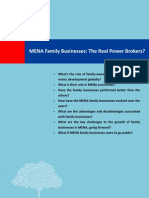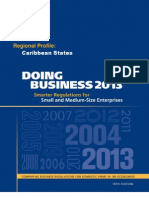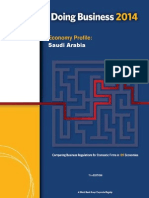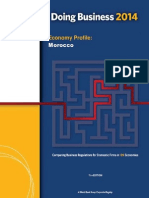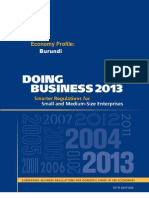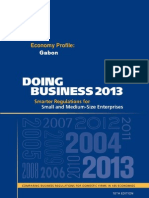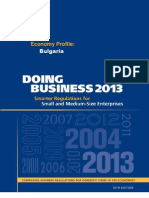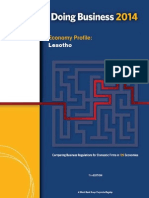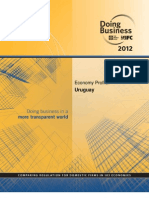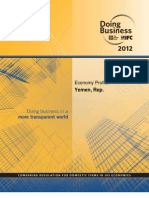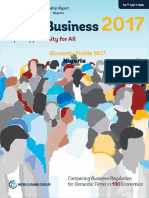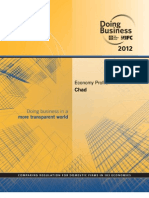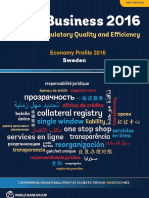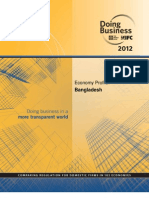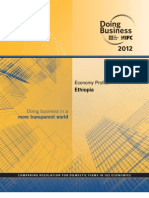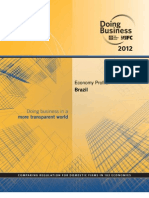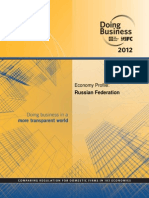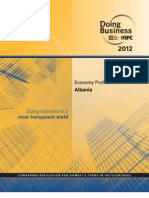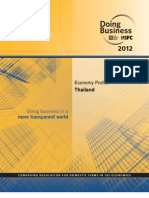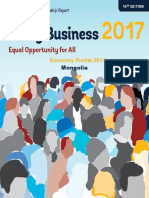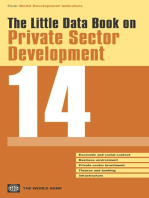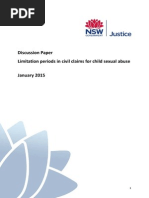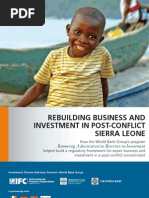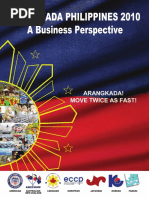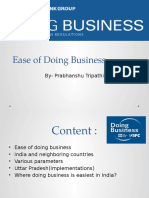World Bank Doing Business 2014 Report
World Bank Doing Business 2014 Report
Uploaded by
ABC News OnlineCopyright:
Available Formats
World Bank Doing Business 2014 Report
World Bank Doing Business 2014 Report
Uploaded by
ABC News OnlineOriginal Description:
Original Title
Copyright
Available Formats
Share this document
Did you find this document useful?
Is this content inappropriate?
Copyright:
Available Formats
World Bank Doing Business 2014 Report
World Bank Doing Business 2014 Report
Uploaded by
ABC News OnlineCopyright:
Available Formats
Regional Profile: East Asia Pacific Islands
Doing Business 2014
EAST ASIA PACIFIC ISLANDS
2013 The International Bank for Reconstruction and Development / The World Bank 1818 H Street NW, Washington, DC 20433 Telephone: 202-473-1000; Internet: www.worldbank.org All rights reserved. 1 2 3 4 15 14 13 12 A copublication of The World Bank and the International Finance Corporation. This work is a product of the staff of The World Bank with external contributions. Note that The World Bank does not necessarily own each component of the content included in the work. The World Bank therefore does not warrant that the use of the content contained in the work will not infringe on the rights of third parties. The risk of claims resulting from such infringement rests solely with you. The findings, interpretations, and conclusions expressed in this work do not necessarily reflect the views of The World Bank, its Board of Executive Directors, or the governments they represent. The World Bank does not guarantee the accuracy of the data included in this work. The boundaries, colors, denominations, and other information shown on any map in this work do not imply any judgment on the part of The World Bank concerning the legal status of any territory or the endorsement or acceptance of such boundaries. Nothing herein shall constitute or be considered to be a limitation upon or waiver of the privileges and immunities of The World Bank, all of which are specifically reserved. Rights and Permissions
This work is available under the Creative Commons Attribution 3.0 Unported license (CC BY 3.0) http://creativecommons.org/licenses/by/3.0. Under the Creative Commons Attribution license, you are free to copy, distribute, transmit, and adapt this work, including for commercial purposes, under the following conditions: AttributionPlease cite the work as follows: World Bank. 2013. Doing Business 2014: Understanding Smarter Regulations for Small and Medium-Size Enterprises. Washington, DC: World Bank Group. DOI: 10.1596/978-0-8213-9615-5. License: Creative Commons Attribution CC BY 3.0 TranslationsIf you create a translation of this work, please add the following disclaimer along with the attribution: This translation was not created by The World Bank and should not be considered an official World Bank translation. The World Bank shall not be liable for any content or error in this translation . All queries on rights and licenses should be addressed to the Office of the Publisher, The World Bank, 1818 H Street NW, Washington, DC 20433, USA; fax: 202-522-2625; e-mail: pubrights@worldbank.org. Additional copies of all 11 editions of Doing Business may be purchased at www.doingbusiness.org. Cover design: The Word Express
Doing Business 2014
EAST ASIA PACIFIC ISLANDS
CONTENTS
Introduction .................................................................................................................................. 4 The business environment .......................................................................................................... 5 Starting a business ..................................................................................................................... 12 Dealing with construction permits ........................................................................................... 20 Getting electricity ....................................................................................................................... 26 Registering property .................................................................................................................. 33 Getting credit .............................................................................................................................. 39 Protecting investors ................................................................................................................... 44 Paying taxes ................................................................................................................................ 51 Trading across borders .............................................................................................................. 58 Enforcing contracts .................................................................................................................... 67 Resolving insolvency .................................................................................................................. 73 Data notes ................................................................................................................................... 79 Resources on the Doing Business website .............................................................................. 84
Doing Business 2014
EAST ASIA PACIFIC ISLANDS
INTRODUCTION
Doing Business sheds light on how easy or difficult it is for a local entrepreneur to open and run a small to medium-size business when complying with relevant regulations. It measures and tracks changes in regulations affecting 11 areas in the life cycle of a business: starting a business, dealing with construction permits, getting electricity, registering property, getting credit, protecting investors, paying taxes, trading across borders, enforcing contracts, resolving insolvency and employing workers. In a series of annual reports Doing Business presents quantitative indicators on business regulations and the protection of property rights that can be compared across 189 economies, from Afghanistan to Zimbabwe, over time. The data set covers 47 economies in SubSaharan Africa, 33 in Latin America and the Caribbean, 25 in East Asia and the Pacific, 25 in Eastern Europe and Central Asia, 20 in the Middle East and North Africa and 8 in South Asia, as well as 31 OECD highincome economies. The indicators are used to analyze economic outcomes and identify what reforms have worked, where and why. This regional profile presents the Doing Business indicators for economies in East Asia Pacific Islands. It also shows the regional average, the best performance globally for each indicator and data for the following comparator regions: Common Market for Eastern and Southern Africa (COMESA), Caribbean States, East Asia and the Pacific (EAP), South Asia (SA) and OECD High Income. The data in this report are current as of June 1, 2013 (except for the paying taxes indicators, which cover the period JanuaryDecember 2012). The Doing Business methodology has limitations. Other areas important to businesssuch as an economys proximity to large markets, the quality of its infrastructure services (other than those related to trading across borders and getting electricity), the security of property from theft and looting, the transparency of government procurement, macroeconomic conditions or the underlying strength of institutionsare not directly studied by Doing Business. The indicators refer to a specific type of business, generally a local limited liability company operating in the largest business city. Because standard assumptions are used in the data collection, comparisons and benchmarks are valid across economies. The data not only highlight the extent of obstacles to doing business; they also help identify the source of those obstacles, supporting policy makers in designing regulatory reform. More information is available in the full report. Doing Business 2014 presents the indicators, analyzes their relationship with economic outcomes and recommends regulatory reforms. The data, along with information on ordering the Doing Business 2014 report, are available on the Doing Business website at http://www.doingbusiness.org.
Doing Business 2014
EAST ASIA PACIFIC ISLANDS
THE BUSINESS ENVIRONMENT
For policy makers trying to improve their economys regulatory environment for business, a good place to start is to find out how it compares with the regulatory environment in other economies. Doing Business provides an aggregate ranking on the ease of doing business based on indicator sets that measure and benchmark regulations applying to domestic small to medium-size businesses through their life cycle. Economies are ranked from 1 to 189 by the ease of doing business index. For each economy the index is calculated as the ranking on the simple average of its percentile rankings on each of the 10 topics included in the index in Doing Business 2014: starting a business, dealing with construction permits, getting electricity, registering property, getting credit, protecting investors, paying taxes, trading across borders, enforcing contracts and resolving insolvency. The ranking on each topic is the simple average of the percentile rankings on its component indicators (see the data notes for more details). The aggregate ranking on the ease of doing business benchmarks each economys performance on the indicators against that of all other economies in the Doing Business sample (figure 1.1). While this ranking tells much about the business environment in an economy, it does not tell the whole story. The ranking on the ease of doing business, and the underlying indicators, do not measure all aspects of the business environment that matter to firms and investors or that affect the competitiveness of the economy. Still, a high ranking does mean that the government has created a regulatory environment conducive to operating a business.
Figure 1.1 Where economies stand in the global ranking on the ease of doing business
Source: Doing Business database.
Doing Business 2014
EAST ASIA PACIFIC ISLANDS
THE BUSINESS ENVIRONMENT
For policy makers, knowing where their economy stands regional average (figure 1.2). Another perspective is in the aggregate ranking on the ease of doing business is provided by the regional average rankings on the topics useful. Also useful is to know how it ranks compared with included in the ease of doing business index (figure 1.3). other economies in the region and compared with the Figure 1.2 How economies in East Asia Pacific Islands rank on the ease of doing business
*The economy with the best performance globally is included as a benchmark. Source: Doing Business database.
Doing Business 2014
EAST ASIA PACIFIC ISLANDS
THE BUSINESS ENVIRONMENT
Figure 1.3 How East Asia Pacific Islands ranks on Doing Business topics Regional average ranking
Source: Doing Business database.
Doing Business 2014
EAST ASIA PACIFIC ISLANDS
Figure 1.4 How far has East Asia Pacific Islands come in the areas measured by Doing Business?
Note: The distance to frontier measure shows how far on average a region is from the best performance achieved by any region on each Doing Business indicator since 2005, except for the getting electricity indicators, which were introduced in 2009. The measure is normalized to range between 0 and 100, with 100 representing the best performance (the frontier). The overall distance to frontier is the average of the distance to frontier in the first 9 indicator sets shown in the figure and does not include getting electricity. Data on the overall distance to frontier including getting electricity is available at http://www.doingbusiness.org/data/distance-to-frontier. See the data notes for more details on the distance to frontier measure. Source: Doing Business database.
Doing Business 2014
EAST ASIA PACIFIC ISLANDS
THE BUSINESS ENVIRONMENT
Just as the overall ranking on the ease of doing business tells only part of the story, so do changes in that ranking. Yearly movements in rankings can provide some indication of changes in an economys regulatory environment for firms, but they are always relative. An economys ranking might change because of developments in other economies. An economy that implemented business regulation reforms may fail to rise in the rankings (or may even drop) if it is passed by others whose business regulation reforms had a more significant impact as measured by Doing Business. The absolute values of the indicators tell another part of the story (table 1.1). Policy makers can learn much by comparing the indicators for their economy with those for the lowest- and highest-scoring economies in the region as well as those for the best performers globally. These comparisons may reveal unexpected strengths in an area of business regulation such as a regulatory process that can be completed with a small number of procedures in a few days and at a low cost.
Table 1.1 Summary of Doing Business indicators for East Asia Pacific Islands
Indicator Starting a Business (rank) Procedures (number) Time (days) Cost (% of income per capita) Paid-in Min. Capital (% of income per capita) Dealing with Construction Permits (rank) Procedures (number) Time (days) Cost (% of income per capita) Getting Electricity (rank) Procedures (number) Time (days) Cost (% of income per Lowest regional performance 156 (Kiribati) 11 (Fiji) 94.0 (Timor-Leste) 144.4 (Micronesia, Fed. Sts.) 136.2 (Timor-Leste) 165 (Papua New Guinea) 22 (Palau) 238.0 (Timor-Leste) 422.5 (Vanuatu) 159 (Kiribati) 6 (Kiribati) 470 (Micronesia, Fed. Sts.) 5,296.4 (Kiribati) Best regional performance 33 (Samoa) 4 (Tonga)* 9.0 (Samoa)* 3.1 (Timor-Leste) 0.0 (8 Economies*) Regional average 102 7 33.4 30.4 15.3 Best global performance 1 (New Zealand) 1 (New Zealand)* 1.0 (New Zealand) 0.0 (Slovenia) 0.0 (112 Economies*) 1 (Hong Kong SAR, China) 6 (Hong Kong SAR, China) 26.0 (Singapore) 1.1 (Qatar) 1 (Iceland) 3 (10 Economies*) 17 (Germany) 0.0 (Japan)
32 (Marshall Islands)
79
12 (Vanuatu)* 54.0 (Vanuatu) 5.6 (Palau) 24 (Papua New Guinea) 3 (Micronesia, Fed. Sts.)* 34 (Samoa) 57.5 (Papua New
17 123.1 120.0 81 4 121 1,204.8
Doing Business 2014
EAST ASIA PACIFIC ISLANDS
10
Indicator capita) Registering Property (rank) Procedures (number) Time (days) Cost (% of property value) Getting Credit (rank) Strength of legal rights index (0-10) Depth of credit information index (0-6) Public registry coverage (% of adults) Private bureau coverage (% of adults) Protecting Investors (rank) Extent of disclosure index (0-10) Extent of director liability index (0-10) Ease of shareholder suits index (0-10) Strength of investor protection index (0-10) Paying Taxes (rank) Payments (number per year) Time (hours per year) Trading Across Borders (rank) Documents to export (number)
Lowest regional performance
Best regional performance Guinea)
Regional average
Best global performance
(3 Economies*) 10 (Solomon Islands) 513.0 (Kiribati) 15.1 (Tonga) 165 (Timor-Leste)* 2 (Timor-Leste) 2 (Vanuatu)*
20 (Palau) 4 (4 Economies*) 14.0 (Palau) 0.0 (Kiribati) (3 Economies*) 9 (5 Economies*) 4 (Fiji)* 5.4 (Timor-Leste)
116 5 124.9 4.8 100 7 3 5.4 21.9 98 3 4 7 4.8 67 25 163 90 6
1 (Georgia) 1 (4 Economies*) 1.0 (New Zealand)* 0.0 (5 Economies*) 1 (Malaysia)* 10 (10 Economies*) 6 (31 Economies*) 100.0 (Portugal)* 100.0 (22 Economies*) 1 (New Zealand) 10 (10 Economies*) 10 (Cambodia) 10 (3 Economies*) 9.7 (New Zealand) 1 (United Arab Emirates) 3 (Hong Kong SAR, China)* 12 (United Arab Emirates) 1 (Singapore) 2 (Ireland)*
2.8 (Papua New Guinea) 178 (Micronesia, Fed. Sts.)* 0 (Micronesia, Fed. Sts.)* 0 (3 Economies*) 5 (Timor-Leste)* 2.7 (Micronesia, Fed. Sts.)* 116 (Papua New Guinea) 38 (Fiji) 276 (Timor-Leste) 134 (Papua New Guinea) 9 (Fiji)
72.9 (Fiji) 34 (Samoa) 6 (Kiribati) 8 (Fiji) 8 (7 Economies*) 6.3 (Samoa) 10 (Kiribati) 7 (Kiribati) 80 (Solomon Islands) 58 (Samoa) 5 (4 Economies*)
Doing Business 2014
EAST ASIA PACIFIC ISLANDS
11
Indicator Time to export (days) Cost to export (US$ per container) Documents to import (number) Time to import (days) Cost to import (US$ per container) Enforcing Contracts (rank) Time (days) Cost (% of claim) Procedures (number) Resolving Insolvency (rank) Time (years) Cost (% of estate) Recovery rate (cents on the dollar)
Lowest regional performance 30 (Micronesia, Fed. Sts.) 1,490 (Vanuatu) 10 (Fiji) 32 (Papua New Guinea) 1,440 (Vanuatu) 189 (Timor-Leste) 1,285 (Timor-Leste) 163.2 (Timor-Leste) 51 (Timor-Leste) 189 (Timor-Leste)* 5.3 (Micronesia, Fed. Sts.) 38 (5 Economies*) 0.0 (Timor-Leste)*
Best regional performance 18 (Fiji)* 490 (Samoa) 5 (Solomon Islands)* 20 (Solomon Islands) 490 (Tonga) 48 (Tonga) 350 (Tonga) 19.7 (Samoa) 30 (Vanuatu) 50 (Fiji) 1.0 (Solomon Islands) 10 (Fiji) 45.6 (Fiji)
Regional average 23 849 7 26 852 105 618 59.3 38 127 2.5 30 21.2
Best global performance 6 (5 Economies*) 450 (Malaysia) 2 (Ireland)* 4 (Singapore) 440 (Singapore) 1 (Luxembourg) 150 (Singapore) 0.1 (Bhutan) 21 (Singapore)* 1 (Japan) 0.4 (Ireland) 1 (Norway) 92.8 (Japan)
* Two or more economies share the top ranking on this indicator. A number shown in place of an economys name indicates the number of economies that share the top ranking on the indicator. For a list of these economies, see the Doing Business website (http://www.doingbusiness.org). Source: Doing Business database.
Doing Business 2014
EAST ASIA PACIFIC ISLANDS
12
STARTING A BUSINESS
Formal registration of companies has many immediate benefits for the companies and for business owners and employees. Legal entities outlive their founders. Resources are pooled as several shareholders join forces to start a company. Formally registered companies have access to services and institutions from courts to banks as well as to new markets. And their employees can benefit from protections provided by the law. An additional benefit comes with limited liability companies. These limit the financial liability of company owners to their investments, so personal assets of the owners are not put at risk. Where governments make this process easy, more entrepreneurs start businesses in the formal sector, creating more good jobs and generating more revenue for the government. What do the indicators cover? Doing Business measures the ease of starting a business in an economy by recording all procedures officially required or commonly done in practice by an entrepreneur to start up and formally operate an industrial or commercial businessas well as the time and cost required to complete these procedures. It also records the paid-in minimum capital that companies must deposit before registration. The ranking on the ease of starting a business is the simple average of the percentile rankings on the 4 component indicators: procedures, time, cost and paid-in minimum capital requirement. To make the data comparable across economies, Doing Business uses several assumptions about the business and the procedures. It assumes that all information is readily available to the entrepreneur and that there has been no prior contact with officials. It also assumes that the entrepreneur will pay no bribes. And it assumes that the business: Is a 100% domestically owned limited liability company, located in the largest business city. Has between 10 and 50 employees. WHAT THE STARTING A BUSINESS INDICATORS MEASURE Procedures to legally start and operate a company (number) Preregistration (for example, name verification or reservation, notarization) Registration in the economys largest business city Postregistration (for example, social security registration, company seal) Time required to complete each procedure (calendar days) Does not include time spent gathering information Each procedure starts on a separate day (2 procedures cannot start on the same day). Procedures that can be fully completed online are an exception to this rule. Procedure considered completed once final document is received No prior contact with officials Cost required to complete each procedure (% of income per capita) Official costs only, no bribes No professional fees unless services required by law Paid-in minimum capital (% of income per capita) Funds deposited in a bank or with a notary before registration (or within 3 months) Conducts general commercial or industrial activities. Has a start-up capital of 10 times income per capita and has a turnover of at least 100 times income per capita. Does not qualify for any special benefits. Does not own real estate.
Doing Business 2014
EAST ASIA PACIFIC ISLANDS
13
STARTING A BUSINESS Where do the regions economies stand today?
How easy is it for entrepreneurs in economies in East Asia Pacific Islands to start a business? The global rankings of these economies on the ease of starting a business suggest an answer (figure 2.1). The average ranking of the region and comparator regions provide a useful benchmark.
Figure 2.1 How economies in East Asia Pacific Islands rank on the ease of starting a business
Source: Doing Business database.
Doing Business 2014
EAST ASIA PACIFIC ISLANDS
14
STARTING A BUSINESS
The indicators underlying the rankings may be more revealing. Data collected by Doing Business show what it takes to start a business in each economy in the region: the number of procedures, the time, the cost and the paid-in minimum capital requirement (figure 2.2). Comparing these indicators across the region and with averages both for the region and for comparator regions can provide useful insights.
Figure 2.2 What it takes to start a business in economies in East Asia Pacific Islands Procedures (number)
Doing Business 2014
EAST ASIA PACIFIC ISLANDS
15
STARTING A BUSINESS
Time (days)
Doing Business 2014
EAST ASIA PACIFIC ISLANDS
16
STARTING A BUSINESS
Cost (% of income per capita)
Doing Business 2014
EAST ASIA PACIFIC ISLANDS
17
STARTING A BUSINESS
Paid-in minimum capital (% of income per capita)
Source: Doing Business database.
Doing Business 2014
EAST ASIA PACIFIC ISLANDS
18
STARTING A BUSINESS What are the changes over time?
Economies around the world have taken steps making it easier to start a businessstreamlining procedures by setting up a one-stop shop, making procedures simpler or faster by introducing technology, and reducing or eliminating minimum capital requirements. Many have undertaken business registration reforms in stagesand often as part of a larger regulatory reform program. Among the benefits have been greater firm satisfaction and savings and more registered businesses, financial resources and job opportunities. What business registration reforms has Doing Business recorded in East Asia Pacific Islands (table 2.1)?
Table 2.1 How have economies in East Asia Pacific Islands made starting a business easieror not? By Doing Business report year DB year DB2008 DB2009 DB2010 Economy Timor-Leste Tonga Samoa Reform Approvals by the Ministry of Land were eliminated, removing one procedure and reducing the number of days required to start a company. New license regulations reforms have reduced time and cost. Samoa eased the starting a business process by passing a new company act that removed the minimum capital requirement, and simplified various other procedures. Fiji made starting a business more difficult by adding a requirement to obtain a tax identification number when registering a new company. The Solomon Islands made starting a business easier by implementing an online registration process. Tonga made starting a business easier by implementing an electronic system at the registry, which reduced the time required for verification of the uniqueness of the company name and for registration of the company. The costs for the name search, company registration and business license increased, however. Vanuatu made starting a business easier by reducing the time required for company registration at the Vanuatu Financial Services Commission and issuing provisional licenses at the Department of Customs. Timor-Leste made starting a business faster by improving the registration process. Fiji made starting a business more difficult by requiring new companies applying for a business license to obtain a certificate from the national fire authority and a letter of compliance from the Ministry of Labor.
DB2012 DB2012
Fiji Solomon Islands
DB2012
Tonga
DB2012
Vanuatu
DB2012
Timor-Leste
DB2013
Fiji
Doing Business 2014
EAST ASIA PACIFIC ISLANDS
19
Note: For information on reforms in earlier years (back to DB2005), see the Doing Business reports for these years, available at http://www.doingbusiness.org. Source: Doing Business database.
Doing Business 2014
EAST ASIA PACIFIC ISLANDS
20
DEALING WITH CONSTRUCTION PERMITS
Regulation of construction is critical to protect the public. But it needs to be efficient, to avoid excessive constraints on a sector that plays an important part in every economy. Where complying with building regulations is excessively costly in time and money, many builders opt out. They may pay bribes to pass inspections or simply build illegally, leading to hazardous construction that puts public safety at risk. Where compliance is simple, straightforward and inexpensive, everyone is better off. What do the indicators cover? Doing Business records the procedures, time and cost for a business in the construction industry to obtain all the necessary approvals to build a simple commercial warehouse in the economys main city, connect it to basic utilities and register the property so that it can be used as collateral or transferred to another entity. The ranking on the ease of dealing with construction permits is the simple average of the percentile rankings on its component indicators: procedures, time and cost. To make the data comparable across economies, Doing Business uses several assumptions about the business and the warehouse, including the utility connections. The business: Is a limited liability company operating in the construction business and located in the largest business city. Is domestically owned and operated. Has 60 builders and other employees. WHAT THE DEALING WITH CONSTRUCTION PERMITS INDICATORS MEASURE Procedures to legally build a warehouse (number) Submitting all relevant documents and obtaining all necessary clearances, licenses, permits and certificates Submitting all required notifications and receiving all necessary inspections Obtaining utility connections for water, sewerage and a land telephone line Registering the warehouse after its completion (if required for use as collateral or for transfer of warehouse) Time required to complete each procedure (calendar days) Does not include time spent gathering information Each procedure starts on a separate day. Procedures that can be fully completed online are an exception to this rule. Procedure completed once final document is received No prior contact with officials Cost required to complete each procedure (% of income per capita) Official costs only, no bribes Will be connected to water, sewerage (sewage system, septic tank or their equivalent) and a fixed telephone line. The connection to each utility network will be 10 meters (32 feet, 10 inches) long. Will be used for general storage, such as of books or stationery (not for goods requiring special conditions). Will take 30 weeks to construct (excluding all delays due to administrative and regulatory requirements).
The warehouse: Is a new construction (there was no previous construction on the land). Has complete architectural and technical plans prepared by a licensed architect or engineer.
Doing Business 2014
EAST ASIA PACIFIC ISLANDS
21
DEALING WITH CONSTRUCTION PERMITS Where do the regions economies stand today?
How easy it is for entrepreneurs in economies in East Asia Pacific Islands to legally build a warehouse? The global rankings of these economies on the ease of dealing with construction permits suggest an answer (figure 3.1). The average ranking of the region and comparator regions provide a useful benchmark.
Figure 3.1 How economies in East Asia Pacific Islands rank on the ease of dealing with construction permits
Source: Doing Business database.
Doing Business 2014
EAST ASIA PACIFIC ISLANDS
22
DEALING WITH CONSTRUCTION PERMITS
The indicators underlying the rankings may be more revealing. Data collected by Doing Business show what it takes to comply with formalities to build a warehouse in each economy in the region: the number of procedures, the time and the cost (figure 3.2). Comparing these indicators across the region and with averages both for the region and for comparator regions can provide useful insights.
Figure 3.2 What it takes to comply with formalities to build a warehouse in economies in East Asia Pacific Islands Procedures (number)
Doing Business 2014
EAST ASIA PACIFIC ISLANDS
23
DEALING WITH CONSTRUCTION PERMITS
Time (days)
Doing Business 2014
EAST ASIA PACIFIC ISLANDS
24
DEALING WITH CONSTRUCTION PERMITS
Cost (% of income per capita)
* Indicates a no practice mark. See the data notes for details. Source: Doing Business database.
Doing Business 2014
EAST ASIA PACIFIC ISLANDS
25
DEALING WITH CONSTRUCTION PERMITS What are the changes over time?
Smart regulation ensures that standards are met while making compliance easy and accessible to all. Coherent and transparent rules, efficient processes and adequate allocation of resources are especially important in sectors where safety is at stake. Construction is one of them. In an effort to ensure building safety while keeping compliance costs reasonable, governments around the world have worked on consolidating permitting requirements. What construction permitting reforms has Doing Business recorded in East Asia Pacific Islands (table 3.1)?
Table 3.1 How have economies in East Asia Pacific Islands made dealing with construction permits easieror not? By Doing Business report year DB year Economy Reform The City Council adopted new regulations that added three new pre-approval procedures related to health, fire safety, and water and sewage connections. Tonga made obtaining construction permits easier by simplifying procedures and reducing the time to deal with building permits by 15 days. Due to fee increases and high prices on constructions materials, the cost for obtaining a construction permit increased significantly in the Solomon Islands. Vanuatu made dealing with construction permits more difficult by increasing the number of procedures and the cost to obtain a building permit. Fiji made obtaining a construction permit more expensive by implementing a fee for the fire department clearance. Vanuatu made obtaining a construction permit more cumbersome by making a preliminary environmental assessment mandatory and made it more expensive by increasing the fees.
DB2009
Fiji
DB2009
Tonga
DB2010
Solomon Islands
DB2012
Vanuatu
DB2013
Fiji
DB2013
Vanuatu
Note: For information on reforms in earlier years (back to DB2005), see the Doing Business reports for these years, available at http://www.doingbusiness.org. Source: Doing Business database.
Doing Business 2014
EAST ASIA PACIFIC ISLANDS
26
GETTING ELECTRICITY
Access to reliable and affordable electricity is vital for businesses. To counter weak electricity supply, many firms in developing economies have to rely on self-supply, often at a prohibitively high cost. Whether electricity is reliably available or not, the first step for a customer is always to gain access by obtaining a connection. What do the indicators cover? Doing Business records all procedures required for a local business to obtain a permanent electricity connection and supply for a standardized warehouse, as well as the time and cost to complete them. These procedures include applications and contracts with electricity utilities, clearances from other agencies and the external and final connection works. The ranking on the ease of getting electricity is the simple average of the percentile rankings on its component indicators: procedures, time and cost. To make the data comparable across economies, several assumptions are used. The warehouse: Is located in the economys largest business city, in an area where other warehouses are located. Is not in a special economic zone where the connection would be eligible for subsidization or faster service. Has road access. The connection works involve the crossing of a road or roads but are carried out on public land. Is a new construction being connected to electricity for the first time. Has 2 stories, both above ground, with a total surface of about 1,300.6 square meters (14,000 square feet), and is built on a plot of 929 square meters (10,000 square feet). WHAT THE GETTING ELECTRICITY INDICATORS MEASURE Procedures to obtain an electricity connection (number) Submitting all relevant documents and obtaining all necessary clearances and permits Completing all required notifications and receiving all necessary inspections Obtaining external installation works and possibly purchasing material for these works Concluding any necessary supply contract and obtaining final supply Time required to complete each procedure (calendar days) Is at least 1 calendar day Each procedure starts on a separate day Does not include time spent gathering information Reflects the time spent in practice, with little follow-up and no prior contact with officials Cost required to complete each procedure (% of income per capita) Official costs only, no bribes Excludes value added tax
Is 150 meters long. Is to either the low-voltage or the mediumvoltage distribution network and either overhead or underground, whichever is more common in the economy and in the area where the warehouse is located. The length of any connection in the customers private domain is negligible. Requires crossing of a 10-meter road but all the works are carried out in a public land, so there is no crossing into other people's private property.
The electricity connection: Is a 3-phase, 4-wire Y, 140-kilovolt-ampere (kVA) (subscribed capacity) connection.
Doing Business 2014
EAST ASIA PACIFIC ISLANDS
27
Involves installing one electricity meter. The monthly electricity consumption will be 0.07 gigawatt-hour (GWh). The internal electrical wiring has been completed.
Doing Business 2014
EAST ASIA PACIFIC ISLANDS
28
GETTING ELECTRICITY Where do the regions economies stand today?
How easy is it for entrepreneurs in economies in East Asia Pacific Islands to connect a warehouse to electricity? The global rankings of these economies on the ease of getting electricity suggest an answer (figure 4.1). The average ranking of the region and comparator regions provide a useful benchmark.
Figure 4.1 How economies in East Asia Pacific Islands rank on the ease of getting electricity
Source: Doing Business database.
Doing Business 2014
EAST ASIA PACIFIC ISLANDS
29
GETTING ELECTRICITY
The indicators underlying the rankings may be more revealing. Data collected by Doing Business show what it takes to get a new electricity connection in each economy in the region: the number of procedures, the time and the cost (figure 4.2). Comparing these indicators across the region and with averages both for the region and for comparator regions can provide useful insights.
Figure 4.2 What it takes to get an electricity connection in economies in East Asia Pacific Islands Procedures (number)
Doing Business 2014
EAST ASIA PACIFIC ISLANDS
30
GETTING ELECTRICITY
Time (days)
Doing Business 2014
EAST ASIA PACIFIC ISLANDS
31
GETTING ELECTRICITY
Cost (% of income per capita)
Source: Doing Business database.
Doing Business 2014
EAST ASIA PACIFIC ISLANDS
32
GETTING ELECTRICITY What are the changes over time?
Obtaining an electricity connection is essential to enable a business to conduct its most basic operations. In many economies the connection process is complicated by the multiple laws and regulations involvedcovering service quality, general safety, technical standards, procurement practices and internal wiring installations. In an effort to ensure safety in the connection process while keeping connection costs reasonable, governments around the world have worked to consolidate requirements for obtaining an electricity connection. What reforms in getting electricity has Doing Business recorded in East Asia Pacific Islands (table 4.1)?
Table 4.1 How have economies in East Asia Pacific Islands made getting electricity easieror not? By Doing Business report year DB year DB2012 Economy Tonga Reform Tonga made getting electricity faster by implementing a time limit for the safety inspection.
Source: Doing Business database.
Doing Business 2014
EAST ASIA PACIFIC ISLANDS
33
REGISTERING PROPERTY
Ensuring formal property rights is fundamental. Effective administration of land is part of that. If formal property transfer is too costly or complicated, formal titles might go informal again. And where property is informal or poorly administered, it has little chance of being accepted as collateral for loanslimiting access to finance. What do the indicators cover? Doing Business records the full sequence of procedures necessary for a business to purchase property from another business and transfer the property title to the buyers name. The transaction is considered complete when it is opposable to third parties and when the buyer can use the property, use it as collateral for a bank loan or resell it. The ranking on the ease of registering property is the simple average of the percentile rankings on its component indicators: procedures, time and cost. To make the data comparable across economies, several assumptions about the parties to the transaction, the property and the procedures are used. The parties (buyer and seller): Are limited liability companies, 100% domestically and privately owned. Are located in the periurban area of the economys largest business city. Have 50 employees each, all of whom are nationals. Perform general commercial activities. Has no mortgages attached and has been under the same ownership for the past 10 years. Consists of 557.4 square meters (6,000 square feet) of land and a 10-year-old, 2-story warehouse of 929 square meters (10,000 square feet). The warehouse is in good condition and complies with all safety standards, building codes and legal requirements. There is no heating system. The property will be transferred in its entirety. WHAT THE REGISTERING PROPERTY INDICATORS MEASURE Procedures to legally transfer title on immovable property (number) Preregistration procedures (for example, checking for liens, notarizing sales agreement, paying property transfer taxes) Registration procedures in the economys largest business city Postregistration procedures (for example, filing title with the municipality) Time required to complete each procedure (calendar days) Does not include time spent gathering information Each procedure starts on a separate day. Procedures that can be fully completed online are an exception to this rule. Procedure considered completed once final document is received No prior contact with officials Cost required to complete each procedure (% of property value) Official costs only, no bribes No value added or capital gains taxes included
The property (fully owned by the seller): Has a value of 50 times income per capita. The sale price equals the value. Is registered in the land registry or cadastre, or both, and is free of title disputes. Is located in a periurban commercial zone, and no rezoning is required.
Doing Business 2014
EAST ASIA PACIFIC ISLANDS
34
REGISTERING PROPERTY Where do the regions economies stand today?
How easy is it for entrepreneurs in economies in East Asia Pacific Islands to transfer property? The global rankings of these economies on the ease of registering property suggest an answer (figure 5.1). The average ranking of the region and comparator regions provide a useful benchmark.
Figure 5.1 How economies in East Asia Pacific Islands rank on the ease of registering property
Source: Doing Business database.
Doing Business 2014
EAST ASIA PACIFIC ISLANDS
35
REGISTERING PROPERTY
The indicators underlying the rankings may be more revealing. Data collected by Doing Business show what it takes to complete a property transfer in each economy in the region: the number of procedures, the time and the cost (figure 5.2). Comparing these indicators across the region and with averages both for the region and for comparator regions can provide useful insights.
Figure 5.2 What it takes to register property in economies in East Asia Pacific Islands Procedures (number)
Doing Business 2014
EAST ASIA PACIFIC ISLANDS
36
REGISTERING PROPERTY
Time (days)
Doing Business 2014
EAST ASIA PACIFIC ISLANDS
37
REGISTERING PROPERTY
Cost (% of property value)
* Indicates a no practice mark. See the data notes for details. Source: Doing Business database.
Doing Business 2014
EAST ASIA PACIFIC ISLANDS
38
REGISTERING PROPERTY What are the changes over time?
Economies worldwide have been making it easier for entrepreneurs to register and transfer propertysuch as by computerizing land registries, introducing time limits for procedures and setting low fixed fees. Many have cut the time required substantiallyenabling buyers to use or mortgage their property earlier. What property registration reforms has Doing Business recorded in East Asia Pacific Islands (table 5.1)?
Table 5.1 How have economies in East Asia Pacific Islands made registering property easieror not? By Doing Business report year DB year Economy Reform Vanuatu made registering a property more expensive by DB2008 Vanuatu increasing the registration fees for the Deed of Transfer at the Department of Lands Records Samoa shifted from a deed system to a title system and fully DB2011 Samoa computerized its land registry, which reduced the time required to register property by 4 months. The Solomon Islands made registering property faster by DB2012 Solomon Islands separating the land registry from the business and movable property registries. DB2012 DB2012 Tonga Vanuatu Tonga made transferring property more costly. Vanuatu made registering property easier by computerizing the land registry. Fiji made transferring property more difficult by requiring DB2013 Fiji parties to a property transaction to obtain a capital gains tax clearance certificate from the Fiji Revenue and Customs Authority. DB2014 Samoa Samoa made transferring property more expensive by increasing the stamp duty.
Note: For information on reforms in earlier years (back to DB2005), see the Doing Business reports for these years, available at http://www.doingbusiness.org. Source: Doing Business database.
Doing Business 2014
EAST ASIA PACIFIC ISLANDS
39
GETTING CREDIT
Two types of frameworks can facilitate access to credit and improve its allocation: credit information systems and the borrowers and lenders rights in collateral and bankruptcy laws. Credit information systems enable lenders to view a potential borrowers financial history (positive or negative) valuable information to consider when assessing risk. And they permit borrowers to establish a good credit history that will allow easier access to credit. Sound collateral laws enable businesses to use their assets, especially movable property, as security to generate capitalwhile strong creditors rights have been associated with higher ratios of private sector credit to GDP. What do the indicators cover? Doing Business assesses the sharing of credit information and the legal rights of borrowers and lenders with respect to secured transactions through 2 sets of indicators. The depth of credit information index measures rules and practices affecting the coverage, scope and accessibility of credit information available through a public credit registry or a private credit bureau. The strength of legal rights index measures whether certain features that facilitate lending exist within the applicable collateral and bankruptcy laws. Doing Business uses case scenarios to determine the scope of the secured transactions system, involving a secured borrower and a secured lender and examining legal restrictions on the use of movable collateral. These scenarios assume that the borrower: Is a private, incorporated, limited liability company. Has its headquarters and only base of operations in the largest business city. WHAT THE GETTING CREDIT INDICATORS MEASURE Strength of legal rights index (010) Protection of rights of borrowers and lenders through collateral laws Protection of secured creditors rights through bankruptcy laws Depth of credit information index (06) Scope and accessibility of credit information distributed by public credit registries and private credit bureaus Public credit registry coverage (% of adults) Number of individuals and firms listed in public credit registry as percentage of adult population Private credit bureau coverage (% of adults) Number of individuals and firms listed in largest private credit bureau as percentage of adult population
Has up to 100 employees. Is 100% domestically owned, as is the lender.
The ranking on the ease of getting credit is based on the percentile rankings on the sum of its component indicators: the depth of credit information index and the strength of legal rights index.
Doing Business 2014
EAST ASIA PACIFIC ISLANDS
40
GETTING CREDIT Where do the regions economies stand today?
How well do the credit information systems and collateral and bankruptcy laws in economies in East Asia Pacific Islands facilitate access to credit? The global rankings of these economies on the ease of getting credit suggest an answer (figure 6.1). The average ranking of the region and comparator regions provide a useful benchmark.
Figure 6.1 How economies in East Asia Pacific Islands rank on the ease of getting credit
Source: Doing Business database.
Doing Business 2014
EAST ASIA PACIFIC ISLANDS
41
GETTING CREDIT
Another way to assess how well regulations and institutions support lending and borrowing in the region is to look at the distribution of its economies by their scores on the getting credit indicators. Figure 6.2 shows how many economies in the region received a Figure 6.2 How strong are legal rights for borrowers and lenders in economies in East Asia Pacific Islands?
Number of economies in region with each score on strength of legal rights index (010)
particular score on the strength of legal rights index. Figure 6.3 shows the same thing for the depth of credit information index. Higher scores indicate stronger legal rights for borrowers and lenders and more credit information. Figure 6.3 How extensiveand how accessibleis credit information in economies in East Asia Pacific Islands?
Number of economies in region with each score on depth of credit information index (06)
Note: Higher scores indicate that collateral and bankruptcy laws are better designed to facilitate access to credit. Source: Doing Business database.
Note: Higher scores indicate the availability of more credit information, from either a credit registry or a credit bureau, to facilitate lending decisions. Source: Doing Business database.
Doing Business 2014
EAST ASIA PACIFIC ISLANDS
42
GETTING CREDIT What are the changes over time?
When economies strengthen the legal rights of lenders and borrowers under collateral and bankruptcy laws, and increase the scope, coverage and accessibility of credit information, they can increase entrepreneurs access to credit. What credit reforms has Doing Business recorded in East Asia Pacific Islands (table 6.1)?
Table 6.1 How have economies in East Asia Pacific Islands made getting credit easieror not? By Doing Business report year DB year Economy Reform Unified registry exists for all security rights in movable property, and all types of movable assets can be used as collateral and be described generically. Vanuatu passed the Personal Property Securities Act and created a special electronic registry for it. ( The registry was not yet in operation at the time of publication). The Act broadens the scope of assets that can be used as collateral; providing that after-acquired property may be used as collateral and extends the security interest of the creditor to the proceeds of the original asset. It also increases creditor protection by ensuring that secured creditors have priority outside of bankruptcy procedures; over unsecured creditors and subsequently over secured creditors in order of registration. Out-of-court enforcement, allowing the creditor to take and sell the asset, is now also possible. The companies act of 2001 and the securities act became enforced as of July 2008. A corporation can now grant a floating charge (debenture) over all its assets undertaking and goodwill and the security interest is automatically extended to products and proceeds for a floating charge. A unified collateral registry which is centralized geographically became operational in Vanuatu strengthening access to credit and the secured transaction regime. The Marshall Islands improved access to credit through a new law on secured transactions that establishes a central collateral registry, broadens the range of assets that can be used as collateral, allows a general description of debts and obligations and assets granted as collateral and establishes clear priority rules outside bankruptcy for secured creditors.
DB2008
Micronesia, Fed. Sts.
DB2009
Vanuatu
DB2010
Samoa
DB2010
Vanuatu
DB2011
Marshall Islands
Doing Business 2014
EAST ASIA PACIFIC ISLANDS
43
DB year DB2011
Economy Papua New Guinea
Reform Operation of a new private credit bureau improved the credit information system in Papua New Guinea. The Solomon Islands strengthened access to credit by passing a new secured transactions law that broadens the range of assets that can be used as collateral, allows a general description of debts and obligations secured by collateral, permits out-of-court enforcement and creates a collateral registry. Tonga strengthened its secured transactions system by passing a new law that allows a general description of the obligation in the security agreement and gives secured creditors priority outside bankruptcy. Timor-Leste improved its credit information system by establishing a public credit registry. Palau strengthened its secured transactions system through a new law that establishes a centralized collateral registry, broadens the range of assets that can be used as collateral to include future assets, allows a general description in the security agreement of debts and obligations as well as assets pledged as collateral, establishes clear priority rules outside bankruptcy for secured creditors and allows out-of-court enforcement of the collateral. Tonga improved access to credit information by establishing a private credit bureau. Vanuatu improved access to credit information by establishing a private credit bureau.
DB2011
Solomon Islands
DB2012
Tonga
DB2012
Timor-Leste
DB2014
Palau
DB2014
Tonga
DB2014
Vanuatu
Note: For information on reforms in earlier years (back to DB2005), see the Doing Business reports for these years, available at http://www.doingbusiness.org. Source: Doing Business database.
Doing Business 2014
EAST ASIA PACIFIC ISLANDS
44
PROTECTING INVESTORS
Protecting investors matters for the ability of companies to raise the capital they need to grow, innovate, diversify and compete. If the laws do not protect minority shareholders, investors may be reluctant to provide funding to companies through the purchase of shares unless they become the controlling shareholders. Effective regulations define related-party transactions precisely, promote clear and efficient disclosure requirements, require shareholder participation in major decisions of the company and set detailed standards of accountability for company insiders. What do the indicators cover? Doing Business measures the strength of minority shareholder protections against directors use of corporate assets for personal gainor self-dealing. The indicators distinguish 3 dimensions of investor protections: transparency of related-party transactions (extent of disclosure index), liability for self-dealing (extent of director liability index) and minority shareholders access to evidence before and during (ease of shareholder suits index). The ranking on the strength of investor protection index is the simple average of the percentile rankings on these 3 indices. To make the data comparable across economies, a case study uses several assumptions about the business and the transaction. The business (Buyer): Is a publicly traded corporation listed on the economys most important stock exchange (or at least a large private company with multiple shareholders). Has a board of directors and a chief executive officer (CEO) who may legally act on behalf of Buyer where permitted, even if this is not specifically required by law. WHAT THE PROTECTING INVESTORS INDICATORS MEASURE Extent of disclosure index (010) Approval process for related-party transactions Disclosure requirements in case of relatedparty transactions Extent of director liability index (010) Ability of minority shareholders to file a direct or derivative lawsuit Ability of minority shareholders to hold interested parties and members of the approving body liable for prejudicial relatedparty transactions Available legal remedies (damages, disgorgement of profits, fines, imprisonment and rescission of the transaction) Ease of shareholder suits index (010) Access to internal corporate documents (directly or through a government inspector) Documents and information available during trial Strength of investor protection index (010) Simple average of the extent of disclosure, extent of director liability and ease of shareholder suits indices The price is higher than the going price for used trucks, but the transaction goes forward. All required approvals are obtained, and all required disclosures made, though the transaction is prejudicial to Buyer. Shareholders sue the interested parties and the members of the board of directors.
The transaction involves the following details: Mr. James, a director and the majority shareholder of the company, proposes that the company purchase used trucks from another company he owns.
Doing Business 2014
EAST ASIA PACIFIC ISLANDS
45
Doing Business 2014
EAST ASIA PACIFIC ISLANDS
46
PROTECTING INVESTORS Where do the regions economies stand today?
How strong are investor protections against selfdealing in economies in East Asia Pacific Islands? The global rankings of these economies on the strength of investor protection index suggest an answer (figure 7.1). While the indicator does not measure all aspects related to the protection of minority investors, a higher ranking does indicate that an economys regulations offer stronger investor protections against self-dealing in the areas measured.
Figure 7.1 How economies in East Asia Pacific Islands rank on the strength of investor protection index
Source: Doing Business database.
Doing Business 2014
EAST ASIA PACIFIC ISLANDS
47
PROTECTING INVESTORS
But the overall ranking on the strength of investor protection index tells only part of the story. Economies may offer strong protections in some areas but not others. So the number of economies in East Asia Pacific Islands that have a certain score recorded on the extent of disclosure, extent of director liability and ease of shareholder suits indices may also be revealing (figure 7.2). Higher scores indicate stronger investor protections. Comparing the scores across the region on the strength of investor protection index and with averages both for the region and for comparator regions can provide useful insights.
Figure 7.2 How strong are investor protections in economies in East Asia Pacific Islands? Strength of investor protection index (010)
Source: Doing Business database.
Doing Business 2014
EAST ASIA PACIFIC ISLANDS
48
PROTECTING INVESTORS
Extent of disclosure index (010)
Number of economies in region with each score on extent of disclosure index (010)
Extent of director liability index (010)
Number of economies in region with each score on extent of director liability index (010)
Note: Higher scores indicate greater disclosure. Source: Doing Business database.
Note: Higher scores indicate greater liability of directors. Source: Doing Business database.
Doing Business 2014
EAST ASIA PACIFIC ISLANDS
49
PROTECTING INVESTORS
Ease of shareholder suits index (010)
Number of economies in region with each score on ease of shareholder suits index (010)
Note: Higher scores indicate greater powers of shareholders to challenge the transaction. Source: Doing Business database.
Doing Business 2014
EAST ASIA PACIFIC ISLANDS
50
PROTECTING INVESTORS What are the changes over time?
Economies with the strongest protections of minority investors from self-dealing require detailed disclosure and define clear duties for directors. They also have well-functioning courts and up-to-date procedural rules that give minority shareholders the means to prove their case and obtain a judgment within a reasonable time. So reforms to strengthen investor protections may move ahead on different frontssuch as through new or amended company laws, securities regulations or revisions to court procedures. What investor protection reforms has Doing Business recorded in East Asia Pacific Islands (table 7.1)?
Table 7.1 How have economies in East Asia Pacific Islands strengthened investor protectionsor not? By Doing Business report year DB year DB2012 Economy Solomon Islands Reform The Solomon Islands strengthened investor protections by increasing shareholder access to corporate information.
Note: For information on reforms in earlier years (back to DB2005), see the Doing Business reports for these years, available at http://www.doingbusiness.org. Source: Doing Business database.
Doing Business 2014
EAST ASIA PACIFIC ISLANDS
51
PAYING TAXES
Taxes are essential. They fund the public amenities, infrastructure and services that are crucial for a properly functioning economy. But the level of tax rates needs to be carefully chosenand needless complexity in tax rules avoided. According to Doing Business data, in economies where it is more difficult and costly to pay taxes, larger shares of economic activity end up in the informal sector where businesses pay no taxes at all. What do the indicators cover? Using a case scenario, Doing Business measures the taxes and mandatory contributions that a medium-size company must pay in a given year as well as the administrative burden of paying taxes and contributions. This case scenario uses a set of financial statements and assumptions about transactions made over the year. Information is also compiled on the frequency of filing and payments as well as time taken to comply with tax laws. The ranking on the ease of paying taxes is the simple average of the percentile rankings on its component indicators: number of annual payments, time and total tax rate, with a threshold 1 being applied to the total tax rate. To make the data comparable across economies, several assumptions about the business and the taxes and contributions are used. TaxpayerCo is a medium-size business that started operations on January 1, 2011. The business starts from the same financial position in each economy. All the taxes and mandatory contributions paid during the second year of operation are recorded. Taxes and mandatory contributions are measured at all levels of government. WHAT THE PAYING TAXES INDICATORS MEASURE Tax payments for a manufacturing company in 2012 (number per year adjusted for electronic or joint filing and payment) Total number of taxes and contributions paid, including consumption taxes (value added tax, sales tax or goods and service tax) Method and frequency of filing and payment Time required to comply with 3 major taxes (hours per year) Collecting information and computing the tax payable Completing tax return forms, filing with proper agencies Arranging payment or withholding Preparing separate tax accounting books, if required Total tax rate (% of profit) Profit or corporate income tax Social contributions and labor taxes paid by the employer Property and property transfer taxes Dividend, capital gains and financial transactions taxes Waste collection, vehicle, road and other taxes Taxes and mandatory contributions include corporate income tax, turnover tax and all labor taxes and contributions paid by the company. A range of standard deductions exemptions are also recorded. and
The threshold is defined as the highest total tax rate among the top 15% of economies in the ranking on the total tax rate. It is calculated and adjusted on a yearly basis. The threshold is not based on any economic theory of an optimal tax rate that minimizes distortions or maximizes efficiency in the tax system of an economy overall. Instead, it is mainly empirical in nature, set at the lower end of the distribution of tax rates levied on medium-size enterprises in the manufacturing sector as observed through the paying taxes indicators. This reduces the bias in the indicators toward economies that do not need to levy significant taxes on companies like the Doing Business standardized case study company because they raise public revenue in other waysfor example, through taxes on foreign companies, through taxes on sectors other than manufacturing or from natural resources (all of which are outside the scope of the methodology). This years threshold is 25.5%.
Doing Business 2014
EAST ASIA PACIFIC ISLANDS
52
PAYING TAXES Where do the regions economies stand today?
What is the administrative burden of complying with taxes in economies in East Asia Pacific Islandsand how much do firms pay in taxes? The global rankings of these economies on the ease of paying taxes offer useful information for assessing the tax compliance burden for businesses (figure 8.1). The average ranking of the region and comparator regions provide a useful benchmark.
Figure 8.1 How economies in East Asia Pacific Islands rank on the ease of paying taxes
Note: For all economies with a total tax rate below the threshold of 25.5% applied in DB2014, the total tax rate is set at 25.5% for the purpose of calculating the ranking on the ease of paying taxes. Source: Doing Business database.
Doing Business 2014
EAST ASIA PACIFIC ISLANDS
53
PAYING TAXES
The indicators underlying the rankings may be more revealing. Data collected by Doing Business show what it takes to comply with tax regulations in each economy in the regionthe number of payments per year and the time required to prepare and file taxes as well as the total tax rate (figure 8.2). Comparing these indicators across the region and with averages both for the region and for comparator regions can provide useful insights.
Figure 8.2 How easy is it to pay taxes in economies in East Asia Pacific Islandsand what are the total tax rates? Payments (number per year)
Doing Business 2014
EAST ASIA PACIFIC ISLANDS
54
PAYING TAXES
Time (hours per year)
Doing Business 2014
EAST ASIA PACIFIC ISLANDS
55
PAYING TAXES
Total tax rate (% of profit)
Source: Doing Business database.
Doing Business 2014
EAST ASIA PACIFIC ISLANDS
56
PAYING TAXES What are the changes over time?
Economies around the world have made paying taxes faster and easier for businessessuch as by consolidating filings, reducing the frequency of payments or offering electronic filing and payment. Many have lowered tax rates. Changes have brought concrete results. Some economies simplifying tax payment and reducing rates have seen tax revenue rise. What tax reforms has Doing Business recorded in East Asia Pacific Islands (table 8.1)?
Table 8.1 How have economies in East Asia Pacific Islands made paying taxes easieror not? By Doing Business report year DB year DB2009 Economy Samoa Reform Effective 1 January 2007, corporate income tax was lowered to 27% from 29% and and capital gains tax to 27% from 30%. Fiji relieved the tax burden on companies by reducing the DB2010 Fiji corporate income tax rate from 31% to 29% while imposing road user levy on all vehicles DB2010 Tonga Tonga has eased tax burden on business with a new income tax law Timor-Leste has eased the tax burden on business by DB2010 Timor-Leste reducing corporate income tax to 10% and eliminating the alternative minimum tax and the withholdng tax on interest. Tonga simplified the payment of taxes by replacing a 2-tier system with a 25% corporate income tax rate for both DB2011 Tonga domestic and foreign companies and introducing tax incentives with a broad-based capital allowance system to replace tax holidays and other tax concessions. Fiji made paying taxes less costly for companies by reducing DB2013 Fiji the profit tax rate. At the same time, Fiji introduced capital gains tax. Fiji made paying taxes more complicated for companies by DB2014 Fiji transferring the fringe benefit tax liability from employees to employers and by limiting the deductibility of mandatory contributions. DB2014 Tonga Tonga made paying taxes more complicated for companies
Doing Business 2014
EAST ASIA PACIFIC ISLANDS
57
DB year
Economy
Reform by introducing a superannuation levythough it also abolished the business license for 2013.
Note: For information on reforms in earlier years (back to DB2005), see the Doing Business reports for these years, available at http://www.doingbusiness.org. Source: Doing Business database.
Doing Business 2014
EAST ASIA PACIFIC ISLANDS
58
TRADING ACROSS BORDERS
In todays globalized world, making trade between economies easier is increasingly important for business. Excessive document requirements, burdensome customs procedures, inefficient port operations and inadequate infrastructure all lead to extra costs and delays for exporters and importers, stifling trade potential. Research shows that exporters in developing countries gain more from a 10% drop in their trading costs than from a similar reduction in the tariffs applied to their products in global markets. What do the indicators cover? Doing Business measures the time and cost (excluding tariffs and the time and cost for sea transport) associated with exporting and importing a standard shipment of goods by sea transport, and the number of documents necessary to complete the transaction. The indicators cover procedural requirements such as documentation requirements and procedures at customs and other regulatory agencies as well as at the port. They also cover trade logistics, including the time and cost of inland transport to the largest business city. The ranking on the ease of trading across borders is the simple average of the percentile rankings on its component indicators: documents, time and cost to export and import. To make the data comparable across economies, Doing Business uses several assumptions about the business and the traded goods. The business: Is of medium size and employs 60 people. Is located in the periurban area of the economys largest business city. Is a private, limited liability company, domestically owned, formally registered and operating under commercial laws and regulations of the economy. WHAT THE TRADING ACROSS BORDERS INDICATORS MEASURE
Documents required to export and import (number) Bank documents Customs clearance documents Port and terminal handling documents Transport documents Time required to export and import (days) Obtaining, filling out and submitting all the documents Inland transport and handling Customs clearance and inspections Port and terminal handling Does not include sea transport time Cost required to export and import (US$ per container) All documentation Inland transport and handling Customs clearance and inspections Port and terminal handling Official costs only, no bribes Do not require refrigeration or any other special environment. Do not require any special phytosanitary or environmental safety standards other than accepted international standards. Are one of the economys leading export or import products. Are transported in a dry-cargo, 20-foot full container load.
The traded goods: Are not hazardous nor do they include military items.
Doing Business 2014
EAST ASIA PACIFIC ISLANDS
59
TRADING ACROSS BORDERS Where do the regions economies stand today?
How easy it is for businesses in economies in East Asia Pacific Islands to export and import goods? The global rankings of these economies on the ease of trading across borders suggest an answer (figure 9.1). The average ranking of the region and comparator regions provide a useful benchmark.
Figure 9.1 How economies in East Asia Pacific Islands rank on the ease of trading across borders
Source: Doing Business database.
Doing Business 2014
EAST ASIA PACIFIC ISLANDS
60
TRADING ACROSS BORDERS
The indicators underlying the rankings may be more revealing. Data collected by Doing Business show what it takes to export or import a standard container of goods in each economy in the region: the number of documents, the time and the cost (figure 9.2). Comparing these indicators across the region and with averages both for the region and for comparator regions can provide useful insights.
Figure 9.2 What it takes to trade across borders in economies in East Asia Pacific Islands Documents to export (number)
Doing Business 2014
EAST ASIA PACIFIC ISLANDS
61
TRADING ACROSS BORDERS
Time to export (days)
Doing Business 2014
EAST ASIA PACIFIC ISLANDS
62
TRADING ACROSS BORDERS
Cost to export (US$ per container)
Doing Business 2014
EAST ASIA PACIFIC ISLANDS
63
TRADING ACROSS BORDERS
Documents to import (number)
Doing Business 2014
EAST ASIA PACIFIC ISLANDS
64
TRADING ACROSS BORDERS
Time to import (days)
Doing Business 2014
EAST ASIA PACIFIC ISLANDS
65
TRADING ACROSS BORDERS
Cost to import (US$ per container)
Source: Doing Business database.
Doing Business 2014
EAST ASIA PACIFIC ISLANDS
66
TRADING ACROSS BORDERS What are the changes over time?
In economies around the world, trading across borders as measured by Doing Business has become faster and easier over the years. Governments have introduced tools to facilitate tradeincluding single windows, risk-based inspections and electronic data interchange systems. These changes help improve their trading environment and boost firms international competitiveness. What trade reforms has Doing Business recorded in East Asia Pacific Islands (table 9.1)?
Table 9.1 How have economies in East Asia Pacific Islands made trading across borders easieror not? By Doing Business report year DB year DB2009 Economy Palau Reform Under the Customs Administration Modernization project import time decreased Fiji made trading easier by opening customer care service centers and improving customs operations. Vanuatu made trading across borders faster by upgrading DB2012 Vanuatu Port-Vilas wharf infrastructure, which increased the efficiency of port and terminal handling activities.
Note: For information on reforms in earlier years (back to DB2005), see the Doing Business reports for these years, available at http://www.doingbusiness.org. Source: Doing Business database.
DB2011
Fiji
Doing Business 2014
EAST ASIA PACIFIC ISLANDS
67
ENFORCING CONTRACTS
Effective commercial dispute resolution has many benefits. Courts are essential for entrepreneurs because they interpret the rules of the market and protect economic rights. Efficient and transparent courts encourage new business relationships because businesses know they can rely on the courts if a new customer fails to pay. Speedy trials are essential for small enterprises, which may lack the resources to stay in business while awaiting the outcome of a long court dispute. What do the indicators cover? Doing Business measures the efficiency of the judicial system in resolving a commercial dispute before local courts. Following the step-by-step evolution of a standardized case study, it collects data relating to the time, cost and procedural complexity of resolving a commercial lawsuit. The ranking on the ease of enforcing contracts is the simple average of the percentile rankings on its component indicators: procedures, time and cost. The dispute in the case study involves the breach of a sales contract between 2 domestic businesses. The case study assumes that the court hears an expert on the quality of the goods in dispute. This distinguishes the case from simple debt enforcement. To make the data comparable across economies, Doing Business uses several assumptions about the case: The seller and buyer are located in the economys largest business city. The buyer orders custom-made goods, then fails to pay. The seller sues the buyer before a competent court. The value of the claim is 200% of income per capita. The seller requests a pretrial attachment to secure the claim. WHAT THE ENFORCING CONTRACTS INDICATORS MEASURE Procedures to enforce a contract through the courts (number) Steps to file and serve the case Steps for trial and judgment Steps to enforce the judgment Time required to complete procedures (calendar days) Time to file and serve the case Time for trial and obtaining judgment Time to enforce the judgment Cost required to complete procedures (% of claim) Average attorney fees Court costs Enforcement costs
The dispute on the quality of the goods requires an expert opinion. The judge decides in favor of the seller; there is no appeal. The seller enforces the judgment through a public sale of the buyers movable assets.
Doing Business 2014
EAST ASIA PACIFIC ISLANDS
68
ENFORCING CONTRACTS Where do the regions economies stand today?
How efficient is the process of resolving a commercial dispute through the courts in economies in East Asia Pacific Islands? The global rankings of these economies on the ease of enforcing contracts suggest an answer (figure 10.1). The average ranking of the region and comparator regions provide a useful benchmark.
Figure 10.1 How economies in East Asia Pacific Islands rank on the ease of enforcing contracts
Source: Doing Business database.
Doing Business 2014
EAST ASIA PACIFIC ISLANDS
69
ENFORCING CONTRACTS
The indicators underlying the rankings may also be revealing. Data collected by Doing Business show what it takes to enforce a contract through the courts in each economy in the region: the number of procedures, the time and the cost (figure 10.2). Comparing these indicators across the region and with averages both for the region and for comparator regions can provide useful insights.
Figure 10.2 What it takes to enforce a contract through the courts in economies in East Asia Pacific Islands Procedures (number)
Doing Business 2014
EAST ASIA PACIFIC ISLANDS
70
ENFORCING CONTRACTS
Time (days)
Doing Business 2014
EAST ASIA PACIFIC ISLANDS
71
ENFORCING CONTRACTS
Cost (% of claim)
Source: Doing Business database.
Doing Business 2014
EAST ASIA PACIFIC ISLANDS
72
ENFORCING CONTRACTS What are the changes over time?
Economies in all regions have improved contract enforcement in recent years. A judiciary can be improved in different ways. Higher-income economies tend to look for ways to enhance efficiency by introducing new technology. Lower-income economies often work on reducing backlogs by introducing periodic reviews to clear inactive cases from the docket and by making procedures faster. What reforms making it easier (or more difficult) to enforce contracts has Doing Business recorded in East Asia Pacific Islands (table 10.1)?
Table 10.1 How have economies in East Asia Pacific Islands made enforcing contracts easieror not? By Doing Business report year DB year DB2008 DB2008 Economy Fiji Tonga Reform In Fiji a new case management system has improve court operation. Tonga inplemented an electronic case management system which made resolving commercial disputes faster. The specialized commercial track at the National Court of Papua New Guinea, which was introduced in 2007, has begun to be fully operational improving contract enforcement. Timor-Leste increased court efficiency by training and appointing new judges and passing a new civil procedure code. Palau made enforcing contracts easier by introducing an electronic filing system for court users.
DB2010
Papua New Guinea
DB2011
Timor-Leste
DB2014
Palau
Note: For information on reforms in earlier years (back to DB2005), see the Doing Business reports for these years, available at http://www.doingbusiness.org. Source: Doing Business database.
Doing Business 2014
EAST ASIA PACIFIC ISLANDS
73
RESOLVING INSOLVENCY
A robust bankruptcy system functions as a filter, ensuring the survival of economically efficient companies and reallocating the resources of inefficient ones. Fast and cheap insolvency proceedings result in the speedy return of businesses to normal operation and increase returns to creditors. By improving the expectations of creditors and debtors about the outcome of insolvency proceedings, well-functioning insolvency systems can facilitate access to finance, save more viable businesses and thereby improve growth and sustainability in the economy overall. What do the indicators cover? Doing Business studies the time, cost and outcome of insolvency proceedings involving domestic entities. It does not measure insolvency proceedings of individuals and financial institutions. The data are derived from survey responses by local insolvency practitioners and verified through a study of laws and regulations as well as public information on bankruptcy systems. The ranking on the ease of resolving insolvency is based on the recovery rate, which is recorded as cents on the dollar recouped by creditors through reorganization, liquidation or debt enforcement (foreclosure) proceedings. The recovery rate is a function of time, cost and other factors, such as lending rate and the likelihood of the company continuing to operate. To make the data comparable across economies, Doing Business uses several assumptions about the business and the case. It assumes that the company: Is a domestically owned, limited liability company operating a hotel. Operates in the economys largest business city. Has 201 employees, 1 main secured creditor and 50 unsecured creditors. WHAT THE RESOLVING INSOLVENCY INDICATORS MEASURE Time required to recover debt (years) Measured in calendar years Appeals and requests for extension are included Cost required to recover debt (% of debtors estate) Measured as percentage of estate value Court fees Fees of insolvency administrators Lawyers fees Assessors and auctioneers fees Other related fees Outcome Whether business continues operating as a going concern or business assets are sold piecemeal Recovery rate for creditors (cents on the dollar) Measures the cents on the dollar recovered by creditors Present value of debt recovered Official costs of the insolvency proceedings are deducted Depreciation of furniture is taken into account Outcome for the business (survival or not) affects the maximum value that can be recovered Has a higher value as a going concern and that the efficient outcome is either reorganization or sale as a going concern, not piecemeal liquidation.
Doing Business 2014
EAST ASIA PACIFIC ISLANDS
74
RESOLVING INSOLVENCY Where do the regions economies stand today?
How efficient are insolvency proceedings in economies in East Asia Pacific Islands? The global rankings of these economies on the ease of resolving insolvency suggest an answer (figure 11.1). The average ranking of the region and comparator regions provide a useful benchmark for assessing the efficiency of insolvency proceedings. Speed, low costs and continuation of viable businesses characterize the top-performing economies.
Figure 11.1 How economies in East Asia Pacific Islands rank on the ease of resolving insolvency
Source: Doing Business database.
Doing Business 2014
EAST ASIA PACIFIC ISLANDS
75
RESOLVING INSOLVENCY
The indicators underlying the rankings may be more revealing. Data collected by Doing Business show the average time and cost required to resolve insolvency as well as the average recovery rate (figure 11.2). Comparing these indicators across the region and with averages both for the region and for comparator regions can provide useful insights.
Figure 11.2 How efficient is the insolvency process in economies in East Asia Pacific Islands Time (years)
Doing Business 2014
EAST ASIA PACIFIC ISLANDS
76
RESOLVING INSOLVENCY
Cost (% of estate)
Doing Business 2014
EAST ASIA PACIFIC ISLANDS
77
RESOLVING INSOLVENCY
Recovery rate (cents on the dollar)
* Indicates a no practice mark. See the data notes for details. Source: Doing Business database.
Doing Business 2014
EAST ASIA PACIFIC ISLANDS
78
RESOLVING INSOLVENCY What are the changes over time?
A well-balanced bankruptcy system distinguishes companies that are financially distressed but economically viable from inefficient companies that should be liquidated. But in some insolvency systems even viable businesses are liquidated. This is starting to change. Many recent reforms of bankruptcy laws have been aimed at helping more of the viable businesses survive. What insolvency reforms has Doing Business recorded in East Asia Pacific Islands (table 11.1)?
Table 11.1 How have economies in East Asia Pacific Islands made resolving insolvency easieror not? By Doing Business report year DB year DB2010 DB2012 Economy Samoa Solomon Islands Reform Samoa enacted a new corporate law and a law introducing receivership thus easing the process of closing a business. The Solomon Islands adopted a new law that simplified insolvency proceedings.
Note: For information on reforms in earlier years (back to DB2005), see the Doing Business reports for these years, available at http://www.doingbusiness.org. Source: Doing Business database.
Doing Business 2014
EAST ASIA PACIFIC ISLANDS
79
DATA NOTES
The indicators presented and analyzed in Doing Business measure business regulation and the protection of property rightsand their effect on businesses, especially small and medium-size domestic firms. First, the indicators document the complexity of regulation, such as the number of procedures to start a business or to register and transfer commercial property. Second, they gauge the time and cost to achieve a regulatory goal or comply with regulation, such as the time and cost to enforce a contract, go through bankruptcy or trade across borders. Third, they measure the extent of legal protections of property, for example, the protections of investors against looting by company directors or the range of assets that can be used as collateral according to secured transactions laws. Fourth, a set of indicators documents the tax burden on businesses. Finally, a set of data covers different aspects of employment regulation. The 11 sets of indicators measured in Doing Business were added over time, and the sample of economies expanded. The data for all sets of indicators in Doing Business 2 2014 are for June 2013. rounds of verification, leading to revisions expansions of the information collected. ECONOMY CHARACTERISTICS or
Gross national income per capita Doing Business 2014 reports 2012 income per capita as published in the World Banks World Development Indicators 2013. Income is calculated using the Atlas method (current U.S. dollars). For cost indicators expressed as a percentage of income per capita, 2012 gross national income (GNI) in U.S. dollars is used as the denominator. GNI data were not available from the World Bank for Afghanistan, The Bahamas, Bahrain, Barbados, Brunei Darussalam, Djibouti, the Islamic Republic of Iran, Kuwait, Libya, Myanmar, New Zealand, Oman, San Marino, the Syrian Arab Republic, West Bank and Gaza, and the Republic of Yemen. In these cases GDP or GNP per capita data and growth rates from other sources, such as the International Monetary Funds World Economic Outlook database and the Economist Intelligence Unit, were used. Region and income group Doing Business uses the World Bank regional and income group classifications, available at http://data.worldbank.org/about/countryclassifications. The World Bank does not assign regional classifications to high-income economies. For the purpose of the Doing Business report, highincome OECD economies are assigned the regional classification OECD high income. Figures and tables presenting regional averages include economies from all income groups (low, lower middle, upper middle and high income). Population Doing Business 2014 reports midyear 2012 population statistics as published in World Development Indicators 2013. The Doing Business methodology offers several advantages. It is transparent, using factual information
Methodology
The Doing Business data are collected in a standardized way. To start, the Doing Business team, with academic advisers, designs a questionnaire. The questionnaire uses a simple business case to ensure comparability across economies and over timewith assumptions about the legal form of the business, its size, its location and the nature of its operations. Questionnaires are administered to more than 10,200 local experts, including lawyers, business consultants, accountants, freight forwarders, government officials and other professionals routinely administering or advising on legal and regulatory requirements (table 21.2). These experts have several rounds of interaction with the Doing Business team, involving conference calls, written correspondence and visits by the team. For Doing Business 2014 team members visited 33 economies to verify data and recruit respondents. The data from questionnaires are subjected to numerous
The data for paying taxes refer to January December 2012.
Doing Business 2014
EAST ASIA PACIFIC ISLANDS
80
about what laws and regulations say and allowing multiple interactions with local respondents to clarify potential misinterpretations of questions. Having representative samples of respondents is not an issue; Doing Business is not a statistical survey, and the texts of the relevant laws and regulations are collected and answers checked for accuracy. The methodology is inexpensive and easily replicable, so data can be collected in a large sample of economies. Because standard assumptions are used in the data collection, comparisons and benchmarks are valid across economies. Finally, the data not only highlight the extent of specific regulatory obstacles to business but also identify their source and point to what might be reformed. Information on the methodology for each Doing Business topic can be found on the Doing Business website at http://www.doingbusiness.org/methodology.
reasons the time delays reported in Doing Business 2014 would differ from the recollection of entrepreneurs reported in the World Bank Enterprise Surveys or other perception surveys. This year Doing Business completed subnational studies in Colombia, Italy and the city of Hargeisa (Somaliland) and is currently updating indicators in Egypt, Mexico and Nigeria. Doing Business also published regional studies for the g7+ and the East African Community. The g7+ group is a countryowned and country-led global mechanism established in April 2010 to monitor, report and draw attention to the unique challenges faced by fragile states. The member countries included in the report are Afghanistan, Burundi, the Central African Republic, Chad, the Comoros, the Democratic Republic of Congo, Cte dIvoire, Guinea, Guinea-Bissau, Haiti, Liberia, Papua New Guinea, Sierra Leone, the Solomon Islands, South Sudan, Timor-Leste and Togo. The subnational studies point to differences in business regulation and its implementation as well as in the pace of regulatory reformacross cities in the same economy. For several economies subnational studies are now periodically updated to measure change over time or to expand geographic coverage to additional cities. This year that is the case for all the subnational studies published.
Limits to what is measured
The Doing Business methodology has 5 limitations that should be considered when interpreting the data. First, the collected data refer to businesses in the economys largest business city (which in some economies differs from the capital) and may not be representative of regulation in other parts of the economy. To address this limitation, subnational Doing Business indicators were created (box 21.1). Second, the data often focus on a specific business formgenerally a limited liability company (or its legal equivalent) of a specified sizeand may not be representative of the regulation on other businesses, for example, sole proprietorships. Third, transactions described in a standardized case scenario refer to a specific set of issues and may not represent the full set of issues a business encounters. Fourth, the measures of time involve an element of judgment by the expert respondents. When sources indicate different estimates, the time indicators reported in Doing Business represent the median values of several responses given under the assumptions of the standardized case. Finally, the methodology assumes that a business has full information on what is required and does not waste time when completing procedures. In practice, completing a procedure may take longer if the business lacks information or is unable to follow up promptly. Alternatively, the business may choose to disregard some burdensome procedures. For both
Changes in what is measured
The methodology for 2 indicator setstrading across borders and paying taxeswas updated this year. For trading across borders, documents that are required purely for purposes of preferential treatment are no longer included in the list of documents (for example, a certificate of origin if the use is only to qualify for a preferential tariff rate under trade agreements). For paying taxes, the value of fuel taxes is no longer included in the total tax rate because of the difficulty of computing these taxes in a consistent way across all economies covered. The fuel tax amounts are in most cases very small, and measuring these amounts is often complicated because they depend on fuel consumption. Fuel taxes continue to be counted in the number of payments. In a change involving several indicator sets, the rule establishing that each procedure must take at least 1 day was removed for procedures that can be fully
Doing Business 2014
EAST ASIA PACIFIC ISLANDS
81
completed online in just a few hours. This change affects the time indicator for starting a business, dealing with construction permits and registering 3 property. For procedures that can be fully completed online, the duration is now set at half a day rather than a full day. The threshold for the total tax rate introduced in 2011 for the purpose of calculating the ranking on the ease of paying taxes was updated. All economies with a total tax rate below the threshold (which is calculated and adjusted on a yearly basis) receive the same ranking on the total tax rate indicator. The threshold is not based on any economic theory of an optimal tax rate that minimizes distortions or maximizes efficiency in the tax system of an economy overall. Instead, it is mainly empirical in nature, set at the lower end of the distribution of tax rates levied on medium-size enterprises in the manufacturing sector as observed through the paying taxes indicators. This reduces the bias in the indicators toward economies that do not need to levy significant taxes on companies like the Doing Business standardized case study company because they raise public revenue in other waysfor example, through taxes on foreign companies, through taxes on sectors other than manufacturing or from natural resources (all of which are outside the scope of the methodology). This year the threshold is 25,5%.
business and the distance to frontier measure. The ease of doing business ranking compares economies with one another, while the distance to frontier measure benchmarks economies to the frontier in regulatory practice, measuring the absolute distance to the best performance on each indicator. Both measures can be used for comparisons over time. When compared across years, the distance to frontier measure shows how much the regulatory environment for local entrepreneurs in each economy has changed over time in absolute terms, while the ease of doing business ranking can show only relative change. Ease of doing business The ease of doing business index ranks economies from 1 to 189. For each economy the ranking is calculated as the simple average of the percentile rankings on each of the 10 topics included in the index in Doing Business 2014: starting a business, dealing with construction permits, getting electricity, registering property, getting credit, protecting investors, paying taxes, trading across borders, enforcing contracts, and resolving insolvency. The employing workers indicators are not included in this years aggregate ease of doing business ranking. Construction of the ease of doing business index Here is one example of how the ease of doing business index is constructed. In Denmark it takes 4 procedures, 5.5 days and 0.2% of annual income per capita in fees to open a business. The minimum capital requirement is 24% of annual income per capita. On these 4 indicators Denmark ranks in the 12th, 11th, 1st and 79th percentiles. So on average Denmark ranks in the 25th percentile on the ease of starting a business. It ranks in the 21st percentile on getting credit, 19th percentile on paying taxes, 27th percentile on enforcing contracts, 5th percentile on resolving insolvency and so on. Higher rankings indicate simpler regulation and stronger protection of property rights. The simple average of Denmarks percentile rankings on all topics is 17th. When all economies are ordered by their average percentile rankings, Denmark stands at 5 in the aggregate ranking on the ease of doing business. More complex aggregation methodssuch as principal components and unobserved components yield a ranking nearly identical to the simple average
Data challenges and revisions
Most laws and regulations underlying the Doing Business data are available on the Doing Business website at http://www.doingbusiness.org. All the sample questionnaires and the details underlying the indicators are also published on the website. Questions on the methodology and challenges to data can be submitted through the websites Ask a Question function at http://www.doingbusiness.org.
Ease of doing business and distance to frontier
Doing Business 2014 presents results for 2 aggregate measures: the aggregate ranking on the ease of doing
For getting electricity the rule that each procedure must take a minimum of 1 day still applies because in practice there are no cases in which procedures can be fully completed online in less than a day. For example, even though in some cases it is possible to apply for an electricity connection online, additional requirements mean that the process cannot be completed in less than 1 day.
3
Doing Business 2014
EAST ASIA PACIFIC ISLANDS
82
used by Doing Business. Thus, Doing Business uses the simplest method: weighting all topics equally and, within each topic, giving equal weight to each of the topic components. If an economy has no laws or regulations covering a specific areafor example, insolvencyit receives a no practice mark. Similarly, an economy receives a no practice or not possible mark if regulation exists but is never used in practice or if a competing regulation prohibits such practice. Either way, a no practice mark puts the economy at the bottom of the ranking on the relevant indicator. The ease of doing business index is limited in scope. It does not account for an economys proximity to large markets, the quality of its infrastructure services (other than services related to trading across borders and getting electricity), the strength of its financial system, the security of property from theft and looting, macroeconomic conditions or the strength of underlying institutions. Variability of economies rankings across topics Each indicator set measures a different aspect of the business regulatory environment. The rankings of an economy can vary, sometimes significantly, across indicator sets. The average correlation coefficient between the 10 indicator sets included in the aggregate ranking is 0.38, and the coefficients between any 2 sets of indicators range from 0.18 (between getting electricity and getting credit) to 0.58 (between trading across borders and resolving insolvency and between trading across borders and getting electricity). These correlations suggest that economies rarely score universally well or universally badly on the indicators. Consider the example of Canada. It stands at 19 in the aggregate ranking on the ease of doing business. Its ranking is 2 on starting a business, 4 on protecting investors, and 8 on paying taxes. But its ranking is only
4
58 on enforcing contracts, 116 on dealing with construction permits and 145 on getting electricity. Variation in performance across the indicator sets is not at all unusual. It reflects differences in the degree of priority that government authorities give to particular areas of business regulation reform and the ability of different government agencies to deliver tangible results in their area of responsibility. Distance to frontier measure A drawback of the ease of doing business ranking is that it can measure the regulatory performance of economies only relative to the performance of others. It does not provide information on how the absolute quality of the regulatory environment is improving over time. Nor does it provide information on how large the gaps are between economies at a single point in time. The distance to frontier measure is designed to address both shortcomings, complementing the ease of doing business ranking. This measure illustrates the distance of an economy to the frontier, and the change in the measure over time shows the extent to which the economy has closed this gap. The frontier is a score derived from the most efficient practice or highest score achieved on each of the component indicators in 10 Doing Business indicator sets (excluding the employing workers indicators) by any economy. In starting a business, for example, Canada and New Zealand have achieved the highest performance on the number of procedures required (1) and on the time (0.5 days), Denmark and Slovenia on the cost (0% of income per capita) and Chile, Zambia and 99 other economies on the paid-in minimum capital requirement (0% of income per capita) (table 22.2). Calculating the distance to frontier for each economy involves 2 main steps. First, individual indicator scores are normalized to a common unit: except for the total tax rate, each of the 31 component indicators y is rescaled to (max y)/(max min), with the minimum value (min) representing the frontierthe highest performance on that indicator across all economies 5 since 2003 or the first year the indicator was collected. For the total tax rate, consistent with the calculation of
Even though scores for the distance to frontier are calculated from 2005, data from as early as 2003 are used to define the frontier
5
See Simeon Djankov, Darshini Manraj, Caralee McLiesh and Rita Ramalho, Doing Business Indicators: Why Aggregate, and How to Do It (World Bank, Washington, DC, 2005). Principal components and unobserved components methods yield a ranking nearly identical to that from the simple average method because both these methods assign roughly equal weights to the topics, since the pairwise correlations among indicators do not differ much. An alternative to the simple average method is to give different weights to the topics, depending on which are considered of more or less importance in the context of a specific economy.
Doing Business 2014
EAST ASIA PACIFIC ISLANDS
83
the rankings, the frontier is defined as the total tax rate at the 15th percentile of the overall distribution of total tax rates for all years. Second, for each economy the scores obtained for individual indicators are aggregated through simple averaging into one distance to frontier score, first for each topic and then across all topics. An economys distance to frontier is indicated on a scale from 0 to 100, where 0 represents the lowest performance and 100 the frontier. The maximum (max) and minimum (min) observed values are computed for all economies included in the Doing Business sample since 2003 and for all years (from 2003 to 2013). To mitigate the effects of extreme outliers in the distributions of the rescaled data (very few economies need 694 days to complete the procedures to start a business, but many need 9 days), th the maximum (max) is defined as the 95 percentile of the pooled data for all economies and all years for each indicator. The exceptions are the getting credit, protecting investors and resolving insolvency indicators, whose construction precludes outliers. In addition, the cost to export and cost to import for each year are divided by the GDP deflator, so as to take the general price level into account when benchmarking these absolute-cost indicators across economies with different inflation trends. The base year for the deflator is 2013 for all economies. The difference between an economys distance to frontier score in any previous year and its score in 2013 illustrates the extent to which the economy has closed the gap to the frontier over time. And in any given year the score measures how far an economy is from the highest performance at that time. Take Colombia, which has a score of 70.5 on the distance to frontier measure for 2014. This score indicates that the economy is 29.5 percentage points away from the frontier constructed from the best performances across all economies and all years. Colombia was further from the frontier in 2009, with a score of 66.2. The difference between the scores shows an improvement over time. The distance to frontier measure can also be used for comparisons across economies in the same year, complementing the ease of doing business ranking. For example, Colombia stands at 63 this year in the ease of doing business ranking, while Peru, which is 29.3 percentage points from the frontier, stands at 42.
Economies that improved the most across 3 or more Doing Business topics in 2012/13 Doing Business 2014 uses a simple method to calculate which economies improved the most in the ease of doing business. First, it selects the economies that in 2012/13 implemented regulatory reforms making it easier to do business in 3 or more of the 10 topics 6 included in this years ease of doing business ranking. Twenty-nine economies meet this criterion: Azerbaijan, Belarus, Burundi, Cte dIvoire, Croatia, Djibouti, Gabon, Guatemala, Guinea, Italy, Kosovo, Latvia, the former Yugoslav Republic of Macedonia, Malaysia, Mauritius, Mexico, Moldova, Mongolia, Morocco, Panama, the Philippines, the Republic of Congo, Romania, the Russian Federation, Rwanda, Sri Lanka, Ukraine, Uzbekistan and the United Arab Emirates. Second, Doing Business sorts these economies on the increase in their distance to frontier measure from the previous year using comparable data. Selecting the economies that implemented regulatory reforms in at least 3 topics and improved the most in the distance to frontier measure is intended to highlight economies with ongoing, broadbased reform programs. The criterion for identifying the top improvers was changed from last year. The improvement in ease of doing business ranking is no longer used. The improvement in the distance to frontier measure is used instead because under this measure economies are sorted according to their absolute improvement instead of relative improvement.
Doing Business reforms making it more difficult to do business are subtracted from the total number of those making it easier to do business.
6
RESOURCES ON THE DOING BUSINESS WEBSITE
Current features News on the Doing Business project http://www.doingbusiness.org Rankings How economies rankfrom 1 to 189 http://www.doingbusiness.org/rankings/ Data All the data for 189 economiestopic rankings, indicator values, lists of regulatory procedures and details underlying indicators http://www.doingbusiness.org/data/ Reports Access to Doing Business reports as well as subnational and regional reports, reform case studies and customized economy and regional profiles http://www.doingbusiness.org/reports/ Methodology The methodologies and research papers underlying Doing Business http://www.doingbusiness.org/methodology/ Research Abstracts of papers on Doing Business topics and related policy issues http://www.doingbusiness.org/research/ Business reforms Short summaries of DB2014 business reforms, lists of reforms since DB2008 and a ranking simulation tool http://www.doingbusiness.org/reforms/ Historical data Customized data sets since DB2004 http://www.doingbusiness.org/custom-query/ Law library Online collection of business laws and regulations relating to business and gender issues http://www.doingbusiness.org/law-library/ http://wbl.worldbank.org/ Contributors More than 10,200 specialists in 189 economies who participate in Doing Business http://www.doingbusiness.org/contributors/doingbusiness/ Entrepreneurship data Data on business density for 139 economies http://www.doingbusiness.org/data/exploretopics /entrepreneurship/ Doing Business iPhone App Doing Business at a Glance App presents the full report, rankings and highlights http://www.doingbusiness.org/specialfeatures/
You might also like
- Marketing Analysis of Indonesia Concerning Microwave OvensDocument29 pagesMarketing Analysis of Indonesia Concerning Microwave OvensMindy Wiriya SarikaNo ratings yet
- MENA Family Businesses Report 17-Apr-11Document30 pagesMENA Family Businesses Report 17-Apr-11ramdams100% (1)
- FINAL Lemsic Qualitative Ease of Doing Business QuestionnaireDocument2 pagesFINAL Lemsic Qualitative Ease of Doing Business QuestionnaireInah Ramos100% (4)
- DB13 Caribbean StatesDocument82 pagesDB13 Caribbean StatesWelete Cabrera WickhamNo ratings yet
- St. Senegal: Soeconomy Economy ProfileDocument108 pagesSt. Senegal: Soeconomy Economy ProfileFbel XNONNo ratings yet
- St. Pakistan: Soeconomy Economy ProfileDocument112 pagesSt. Pakistan: Soeconomy Economy ProfileSalman JoharNo ratings yet
- Doing Busness in KSA 2014Document108 pagesDoing Busness in KSA 2014Matthew BennettNo ratings yet
- St. Morocco: Soeconomy Economy ProfileDocument109 pagesSt. Morocco: Soeconomy Economy ProfileL'Usine NouvelleNo ratings yet
- Economy Profile:: BarbadosDocument111 pagesEconomy Profile:: Barbadosgreat2readNo ratings yet
- BDI Doing Business 2013Document114 pagesBDI Doing Business 2013Christian RumuNo ratings yet
- DoingBusiness GAB PDFDocument111 pagesDoingBusiness GAB PDFnyrvanNo ratings yet
- St. Bulgaria: EconomyDocument116 pagesSt. Bulgaria: Economygreat2readNo ratings yet
- St. Lesotho: Soeconomy Economy ProfileDocument106 pagesSt. Lesotho: Soeconomy Economy ProfileBharat SethNo ratings yet
- MexicoDocument114 pagesMexicoAnum Hamid100% (1)
- MDA World BankDocument113 pagesMDA World BankAna ZnaceniNo ratings yet
- Dados UruguayDocument103 pagesDados UruguayAlessandro Costa E SilvaNo ratings yet
- @WorldBank Report - Doing Business in #Yemen 2012Document102 pages@WorldBank Report - Doing Business in #Yemen 2012Yemen ExposedNo ratings yet
- NGADocument141 pagesNGAAravindan ChandrasekaranNo ratings yet
- Vietnam: Economy ProfileDocument104 pagesVietnam: Economy ProfileLưu Thuý HằngNo ratings yet
- Vietnam: Economy ProfileDocument104 pagesVietnam: Economy ProfilePiyush GaurNo ratings yet
- Malaysia: Economy ProfileDocument103 pagesMalaysia: Economy Profilesime58No ratings yet
- Economy ProfileDocument103 pagesEconomy ProfileNuur AhmedNo ratings yet
- DoingBusinessCIV2012 CDocument102 pagesDoingBusinessCIV2012 Cperico1962No ratings yet
- Doing BusinessDocument105 pagesDoing BusinesseWork-flowNo ratings yet
- RomaniaDocument108 pagesRomaniaSabina Teodora SavaNo ratings yet
- Sweden: Doing Business 2016Document96 pagesSweden: Doing Business 2016Alex PavelNo ratings yet
- EconomyDocument101 pagesEconomyMuhammad HanneytaNo ratings yet
- History of PakistanDocument104 pagesHistory of PakistanBilal HussainNo ratings yet
- DB16 Mini Book PDFDocument64 pagesDB16 Mini Book PDFShahril BudimanNo ratings yet
- Doing BusinessDocument282 pagesDoing BusinessAldax KeelNo ratings yet
- EGYPT Doing Business - World Bank 2012Document104 pagesEGYPT Doing Business - World Bank 2012Nashwa SaadNo ratings yet
- Doing Business in DubaiDocument100 pagesDoing Business in DubaiMuhammad NbNo ratings yet
- Bangladesh: Economy ProfileDocument102 pagesBangladesh: Economy Profileakibul_asif007No ratings yet
- Lao PDR: Economy ProfileDocument101 pagesLao PDR: Economy ProfileAditya MalikNo ratings yet
- Doing Bussiness in EthiopiaDocument100 pagesDoing Bussiness in EthiopiaHenok FasilNo ratings yet
- IB Indian EconomyDocument111 pagesIB Indian EconomyShilpi PachauriNo ratings yet
- Brazil: Economy ProfileDocument107 pagesBrazil: Economy ProfileGaurav SharmaNo ratings yet
- Russian Federation: Economy ProfileDocument110 pagesRussian Federation: Economy ProfileShoaib ZaheerNo ratings yet
- Doing Business 2012 Aalbania World BankDocument102 pagesDoing Business 2012 Aalbania World BankErida BelulajNo ratings yet
- THA Doing BusinessDocument103 pagesTHA Doing BusinessFrancisco CQNo ratings yet
- Doing Business India (WB)Document153 pagesDoing Business India (WB)Jyotpreet SinghNo ratings yet
- Doingbusiness COL2012Document105 pagesDoingbusiness COL2012unibooksNo ratings yet
- Doing Business Macedonia 2012Document101 pagesDoing Business Macedonia 2012Iki VedenNo ratings yet
- Iran, Islamic RepDocument72 pagesIran, Islamic RepChristina GuseynovaNo ratings yet
- WP0 Box 3800 Darussalam 00 Public 0Document89 pagesWP0 Box 3800 Darussalam 00 Public 0sriyonodwizuliyantoNo ratings yet
- Doing Business 2015 Rep DOMDocument91 pagesDoing Business 2015 Rep DOMojasvingNo ratings yet
- Nga PDFDocument129 pagesNga PDFArujNo ratings yet
- Doing Business in Mongolia 2017Document108 pagesDoing Business in Mongolia 2017shagaiNo ratings yet
- Madagascar Doing Business 2016Document109 pagesMadagascar Doing Business 2016mtahinasNo ratings yet
- Profilul Economic Al LuxemburguluiDocument103 pagesProfilul Economic Al LuxemburguluiGiuliano CiolacuNo ratings yet
- A Comprehensive Assessment of Tax Capacity in Southeast AsiaFrom EverandA Comprehensive Assessment of Tax Capacity in Southeast AsiaNo ratings yet
- Provincial Facilitation for Investment and Trade Index: Measuring Economic Governance for Business Development in the Lao People’s Democratic Republic-Second EditionFrom EverandProvincial Facilitation for Investment and Trade Index: Measuring Economic Governance for Business Development in the Lao People’s Democratic Republic-Second EditionNo ratings yet
- Asia Small and Medium-Sized Enterprise Monitor 2020: Volume III: Thematic Chapter—Fintech Loans to Tricycle Drivers in the PhilippinesFrom EverandAsia Small and Medium-Sized Enterprise Monitor 2020: Volume III: Thematic Chapter—Fintech Loans to Tricycle Drivers in the PhilippinesNo ratings yet
- Toward Inclusive Access to Trade Finance: Lessons from the Trade Finance Gaps, Growth, and Jobs SurveyFrom EverandToward Inclusive Access to Trade Finance: Lessons from the Trade Finance Gaps, Growth, and Jobs SurveyNo ratings yet
- Global Financial Development Report 2014: Financial InclusionFrom EverandGlobal Financial Development Report 2014: Financial InclusionNo ratings yet
- Public Financing for Small and Medium-Sized Enterprises: The Cases of the Republic of Korea and the United StatesFrom EverandPublic Financing for Small and Medium-Sized Enterprises: The Cases of the Republic of Korea and the United StatesNo ratings yet
- Hidden Debt: Solutions to Avert the Next Financial Crisis in South AsiaFrom EverandHidden Debt: Solutions to Avert the Next Financial Crisis in South AsiaNo ratings yet
- Reactive Statement From PfizerDocument1 pageReactive Statement From PfizerABC News OnlineNo ratings yet
- Patients First Hospital ActionsDocument2 pagesPatients First Hospital ActionsABC News OnlineNo ratings yet
- Hilda 2017Document121 pagesHilda 2017ABC News OnlineNo ratings yet
- Bullying FR A4 Print PDFDocument72 pagesBullying FR A4 Print PDFABC News OnlineNo ratings yet
- BlackBerry Think Tank Security ReportDocument16 pagesBlackBerry Think Tank Security ReportABC News OnlineNo ratings yet
- Letter From DR Stanley ChiangDocument1 pageLetter From DR Stanley ChiangABC News OnlineNo ratings yet
- Report Into Temporary Work VisasDocument373 pagesReport Into Temporary Work VisasABC News OnlineNo ratings yet
- Right To Information Out of Home Care TasmaniaDocument3 pagesRight To Information Out of Home Care TasmaniaABC News OnlineNo ratings yet
- 2016 AFL FixturesDocument11 pages2016 AFL FixturesABC News OnlineNo ratings yet
- Report Into Temporary Work VisasDocument373 pagesReport Into Temporary Work VisasABC News OnlineNo ratings yet
- David Scott Resignation LetterDocument5 pagesDavid Scott Resignation LetterABC News OnlineNo ratings yet
- Report No. 98 Inspector's OverviewDocument3 pagesReport No. 98 Inspector's OverviewABC News OnlineNo ratings yet
- Rauss Hief Udge Illiman Eputy Hief Udge AND EberDocument11 pagesRauss Hief Udge Illiman Eputy Hief Udge AND EberABC News OnlineNo ratings yet
- ABC Grandstand Cricket Competition T&C 2015Document6 pagesABC Grandstand Cricket Competition T&C 2015ABC News OnlineNo ratings yet
- ABC Grandstand Ashes Photo CompetitionDocument6 pagesABC Grandstand Ashes Photo CompetitionABC News OnlineNo ratings yet
- The Fatwa Issued by Islamic StateDocument1 pageThe Fatwa Issued by Islamic StateABC News OnlineNo ratings yet
- State of The Nation: Incarceration StatisticsDocument2 pagesState of The Nation: Incarceration StatisticsABC News OnlineNo ratings yet
- Proposed New Electorates For ACTDocument1 pageProposed New Electorates For ACTABC News OnlineNo ratings yet
- Discussion Paper Limitation Periods in Civil Claims For Child Sexual Abuse January 2015Document45 pagesDiscussion Paper Limitation Periods in Civil Claims For Child Sexual Abuse January 2015ABC News OnlineNo ratings yet
- Letter To President JinpingDocument2 pagesLetter To President JinpingABC News OnlineNo ratings yet
- Climate Spectator: Landfill Gas Projects Awarded Reverse Auction ContractsDocument2 pagesClimate Spectator: Landfill Gas Projects Awarded Reverse Auction ContractsABC News OnlineNo ratings yet
- Proposed New Electorates For ACTDocument1 pageProposed New Electorates For ACTABC News OnlineNo ratings yet
- THE Australian Renewable Energy Race: Which States Are Winning or Losing?Document52 pagesTHE Australian Renewable Energy Race: Which States Are Winning or Losing?ABC News OnlineNo ratings yet
- Board of Senior Senior Secondary Studies Recognition of Excellence AwardsDocument18 pagesBoard of Senior Senior Secondary Studies Recognition of Excellence AwardsABC News OnlineNo ratings yet
- Discussion Paper Limitation Periods in Civil Claims For Child Sexual Abuse January 2015Document45 pagesDiscussion Paper Limitation Periods in Civil Claims For Child Sexual Abuse January 2015ABC News OnlineNo ratings yet
- Queensland Health DepartmentDocument52 pagesQueensland Health DepartmentABC News OnlineNo ratings yet
- Rebuilding Business and Investment in Post-Conflict Sierra LeoneDocument23 pagesRebuilding Business and Investment in Post-Conflict Sierra LeoneInternational Finance Corporation (IFC)No ratings yet
- Egypt Business Fact SheetDocument22 pagesEgypt Business Fact SheetFatema Nader BahrNo ratings yet
- Asean Fact SheetDocument33 pagesAsean Fact SheetFitri SharifNo ratings yet
- Historical Data DB04 DB20Document2,262 pagesHistorical Data DB04 DB20Manu BalakrishnanNo ratings yet
- Arangkada 2010Document474 pagesArangkada 2010Aries MatibagNo ratings yet
- The Presidency of Rodrigo Dutere and Political OrderDocument22 pagesThe Presidency of Rodrigo Dutere and Political OrderRaymond AnactaNo ratings yet
- Economy Profile:: BarbadosDocument111 pagesEconomy Profile:: Barbadosgreat2readNo ratings yet
- SSE 108 Module 6Document12 pagesSSE 108 Module 6solomonmaisabel03No ratings yet
- Case 4 - Pakistan A Story of Technology, Entrepreneurs and Global NetworksDocument13 pagesCase 4 - Pakistan A Story of Technology, Entrepreneurs and Global NetworksDana AlthaniNo ratings yet
- Ease of Doing BusinessDocument15 pagesEase of Doing BusinessPragyaNo ratings yet
- Doing Business in Myanmar 2018 PDFDocument66 pagesDoing Business in Myanmar 2018 PDFLet's Save MyanmarNo ratings yet
- Change Management-An Unending Micro and Macro Minuet: Mariela K. Farhi-ZimmermanDocument11 pagesChange Management-An Unending Micro and Macro Minuet: Mariela K. Farhi-ZimmermanChinmayJoshiNo ratings yet
- Venus in Focus: UPSC Newspaper Article AnalysisDocument10 pagesVenus in Focus: UPSC Newspaper Article AnalysisSamarth SinghNo ratings yet
- Business Environment MAIN Book - CA CS Harish Mathariya, YES AcademyDocument43 pagesBusiness Environment MAIN Book - CA CS Harish Mathariya, YES Academysejalmadaan001No ratings yet
- Research Scientist IBM Research Africa DR - Charity Wayua EaseofDoingBusinessReport ConnectedEA2015 1-04-15Document28 pagesResearch Scientist IBM Research Africa DR - Charity Wayua EaseofDoingBusinessReport ConnectedEA2015 1-04-15ICT AUTHORITYNo ratings yet
- 2022 - Top 3 - Predictive Effect of Business Permit Modalities On Selected Economic Indicators Among The Municipalities in The PhilippinesDocument22 pages2022 - Top 3 - Predictive Effect of Business Permit Modalities On Selected Economic Indicators Among The Municipalities in The PhilippinesJan Roger YunsalNo ratings yet
- PM MkssyDocument22 pagesPM MkssyAravind k sNo ratings yet
- Employment News 16 December - 22 DecemberDocument48 pagesEmployment News 16 December - 22 DecemberSarfraz Hussain0% (1)
- Spain PestelDocument93 pagesSpain PestelholaNo ratings yet
- Electricity Tariffs Power Outages and Firm PerformanceDocument41 pagesElectricity Tariffs Power Outages and Firm PerformanceIván Camilo Díez100% (2)
- 2010-1112 Peru CADE PorterDocument83 pages2010-1112 Peru CADE PorteriveradavilaNo ratings yet
- Corporate Law Assignment... Re Ease of Doing Business Under The Cama 2020...Document16 pagesCorporate Law Assignment... Re Ease of Doing Business Under The Cama 2020...adaezeosuchukwuNo ratings yet
- Startups in IndiaDocument13 pagesStartups in IndiaAnimesh Tiwari100% (1)
- INDEXtb - RFPDocument35 pagesINDEXtb - RFPkevin21790No ratings yet
- Vansh Muttreja Thesis - OriginalDocument39 pagesVansh Muttreja Thesis - OriginalrohanNo ratings yet
- ARTADocument22 pagesARTAMARCEL NICOLASNo ratings yet
- 64 Working Paper Dowuona Dec 2011Document117 pages64 Working Paper Dowuona Dec 2011Sharma AartzNo ratings yet

